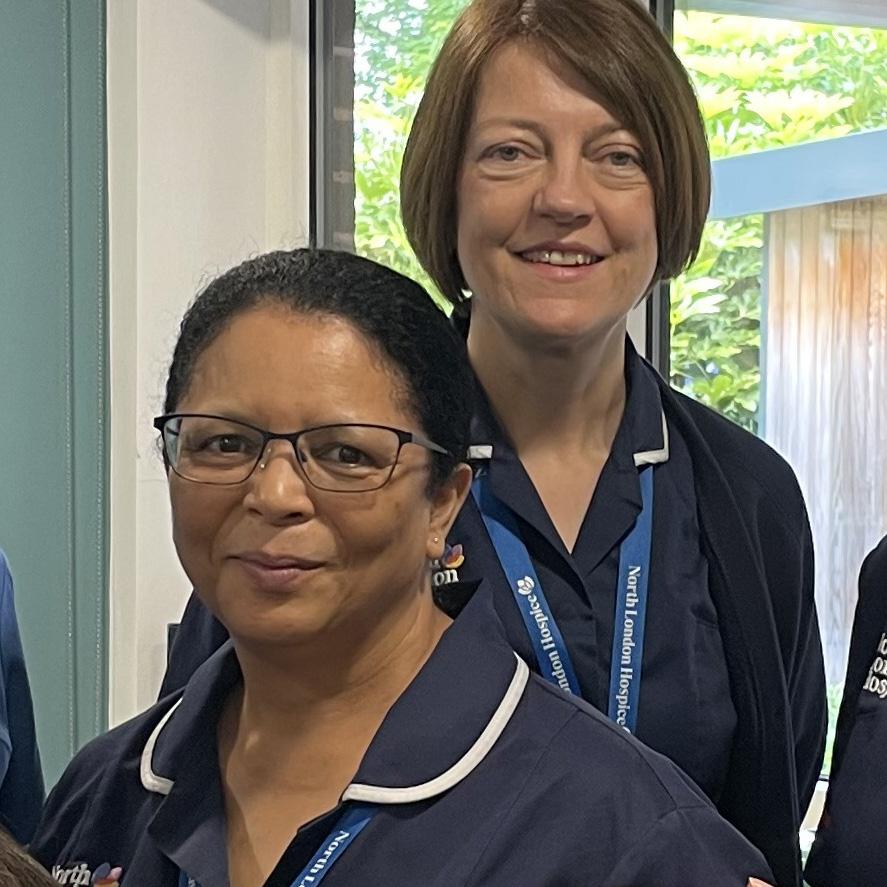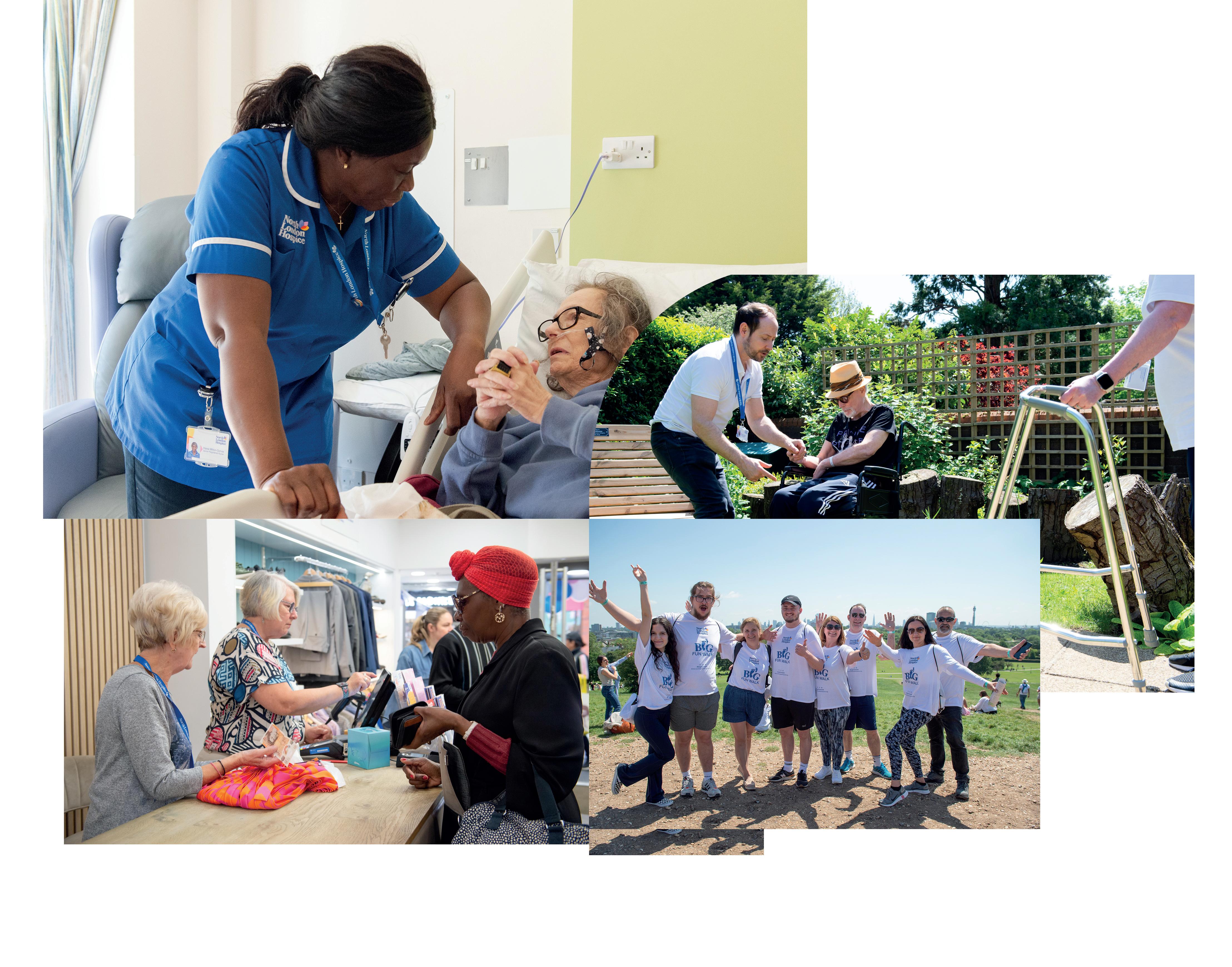

Impact Report & Audited Accounts
2023/24
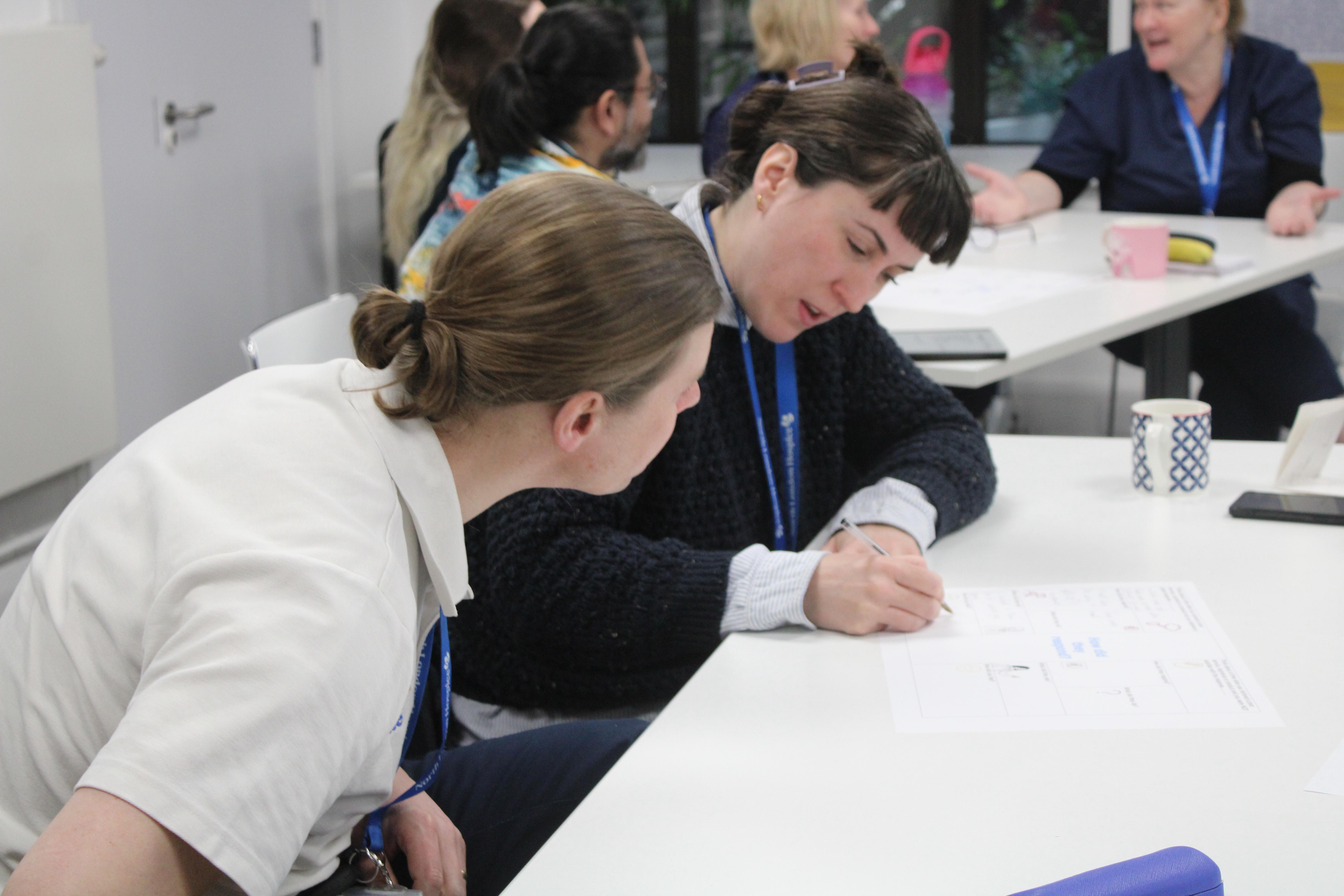
Contents
Message from Chair and Chief Executive
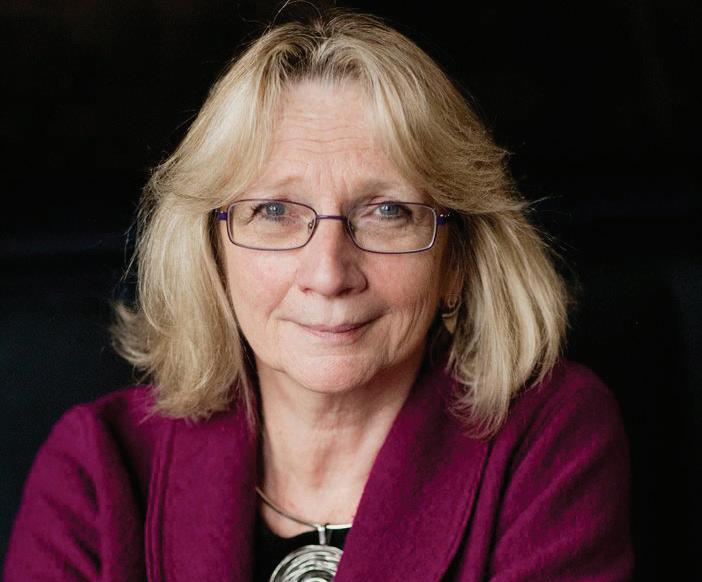
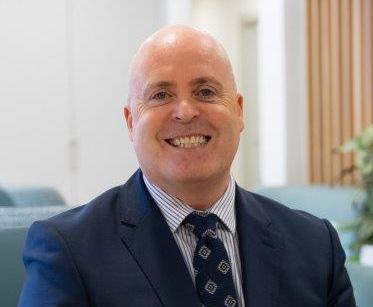
It has been a year of transformation at North London Hospice. We will always be here to deliver the things that matter most to our patients and their families and that will never change.
Whilst we are now well into a period of recovery from the pandemic, we are mindful of the effect that the experience has had on our patients and their loved ones, as well as our staff and volunteers. We have had to adapt and become more agile as an organisation, and whilst changes were not always easy, we are now in a stronger position as we face the future.
We have seen positive changes to our Executive Team with the appointment of Kelvin Walker as Director of Finance and Resources, Suzie Long, Director of People and Culture, and Wolfie Smith, Director of Patient Services. Michelle Forde was also promoted from Head of Quality to a new role, Director of Nursing and Quality. This is a positive change as it ensures that the nursing voice, the biggest group of our clinicians, is present at a senior level as we put the patients at the heart of everything we do.
The Executive Team and Board have been working on a Transformation Plan which includes a financial plan to ensure that our charity is sustainable for the future. Through this planning we should be on course to achieve a balanced budget by 2027.
As we go about planning for a more sustainable future, we have committed to delivering against a new Strategic Plan for 2024-2027. This builds on our previous four-year plan and will help us to transform our services for patients and the wider community. It will also bring in new initiatives through Fundraising and Retail to support our work.
Declan Carroll, Chief Executive
Lis Burgess Jones, Chair
Our colleagues who work in income generation, whether that be the team in fundraising, or our counterparts in our 17 shops, all play a crucial role in ensuring that our services are funded.
We are extremely grateful for their hard work and dedication in achieving an ambitious income target. We all have a part to play in this though, whether this is ensuring that our costs are as low as possible or spreading the word about the hospice, we all have a duty at North London Hospice to contribute towards our sustainability as a charity.
The challenges of the cost-of-living crisis have been well documented and like so many charities, we have also felt the impact, and we are acutely aware of how this has affected our supporters’ ability to give to our appeals.
The challenges of hospice funding are unlikely to go away any time soon. We are grateful for the support of Hospice UK as well as our wider champions in the community, including our constituency MPs who advocate for us and also supported our campaign in 2023/24 to fund our nurses.
Despite the financial pressures we face, we are proud of the way in which our organisation has met challenges. We have much to celebrate and be proud of. We saw an increased reach into our communities through a range of services in our Inpatient Unit, Community Palliative Care and Outpatient and Wellbeing Services.
We are pleased that we are also now able to provide some services to communities in both Camden and Islington in addition to our three boroughs of Barnet, Enfield and Haringey. As we work with our Integrated Care Board (ICB) we are encouraged by the plans to appoint North London Hospice as the lead provider for our Haringey Services from North Middlesex which shows how our relationship with the ICB has been strengthened. We were saddened to hear of the closure of Marie Curie Hospice (Hampstead) in November 2023, but will welcome the opportunity to work with and support the communities across Camden & Islington as we engage with discussions about extended community services.
We will work constructively with a future government to ensure that we are able to continue to serve our communities. The subject of assisted dying is likely to continue to receive attention in the media and wider
society. We continue to have active dialogue with our partners, including Hospice UK, and our stakeholders from across the community. We remain committed to providing palliative care for our patients in line with our vision which is to provide the best of life, at the end of life, for everyone.
Our Board of Trustees has been strengthened by recent appointments who will bring different insights and fresh energy to our governance. We are saddened by Judith Tobin’s announcement that she is going to retire. Judith has been a longstanding and dedicated Trustee and supporter since 2014 and we would like to thank her for her many years of service.
Lis retired as Chair in May 2024, having taken the decision not to stand for a third term. “For me this has been a difficult choice as I have a deep commitment to North London Hospice, its mission, and values. It has been an honour and a privilege to be a Trustee, a Vice Chair and then Chair. It has also been a joy to have worked with such skilled, talented, and committed people. I am very proud to formally hand over the role of Chair of the Board of Trustees to the very capable Vice Chair, Simon Morris MBE.’’
Every day, we all have the pleasure to work alongside the best staff and volunteers who help to make our charity the special place it has become within the communities we support. We can’t put a value on what our services mean to all the patients, families, and friends that we have cared for and supported over the years and will continue to support for years to come, but we can talk with pride, as we hope you all do, about how important our work is at North London Hospice.
Thank you to our staff, volunteers, Trustees and donors that support everything we do – we simply couldn’t do the things we do without your generous support. Thank you for reading – we hope you find this report helpful and informative.
Lis Burgess Jones Chair of Trustees
Declan Carroll Chief Executive
ContentsOur year in numbers
Barnet
23,257
Enfield visits by our Community Palliative Care Service to our patients
Haringey
Haringey
Inpatient Unit
306 admissions (up 7.18% on last year)
14.3 days average length of stay
81% of patients achieving their preferred place of death 73% occupancy
referrals (up 12.1% on last year)
91% of patients achieving their preferred place of death 3155 Community
Total number of calls received through our overnight specialist Community and Palliative Advice Team (5pm-8am)
267 referrals (up 5.6% on last year)
1598 attendees
46
255 Compassionate Neighbours
175 referrals (up 5.71% on last year)
compassionate neighbours trained (up 23.91% on last year)
number of group sessions held (up 29.8% on last year)
600+
Outpatients and Wellbeing Service Community Development
People reached through planned community events such as: death literacy events - Dying Matters, Community Death Cafes, Arts Based Approach to EOL “What Matters Café”. Boxing for Bereavement. Hospice Bingo. Pop-up photography exhibition.
112
Internal mandatory and non-mandatory training sessions for staff People and Culture
external courses delivered to 1221 learners 71
94% staff compliance with mandatory training
602
volunteers registered
employees 230
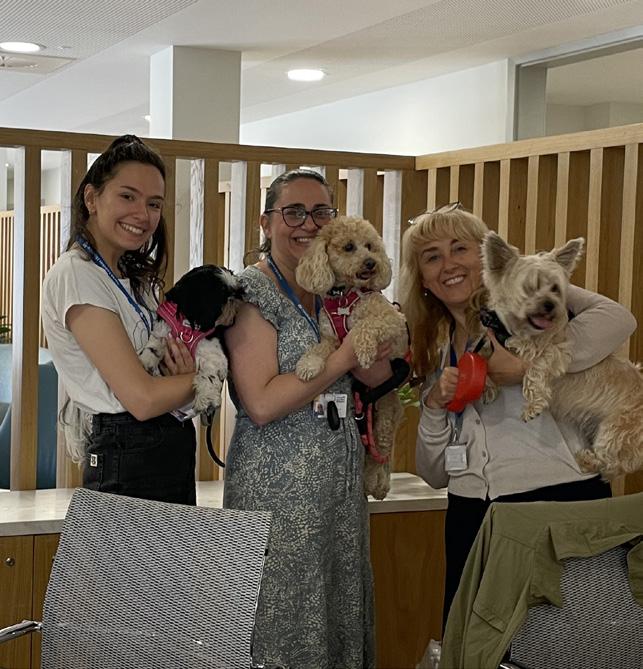
Retail
17
734,385 shops
items sold in our shops, supporting our commitment for recycling and our green pledge
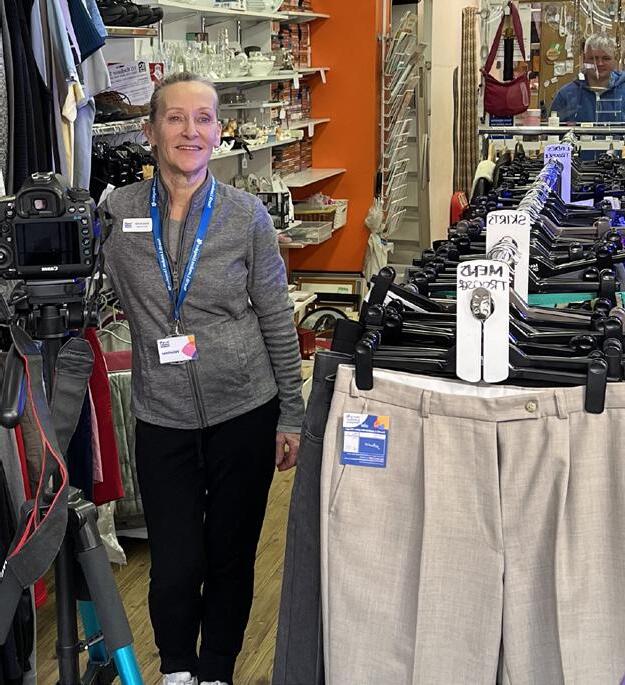
Fundraising
7045 wonderful people left us a gift in their will 49 people and organisations supported us by giving us a gift
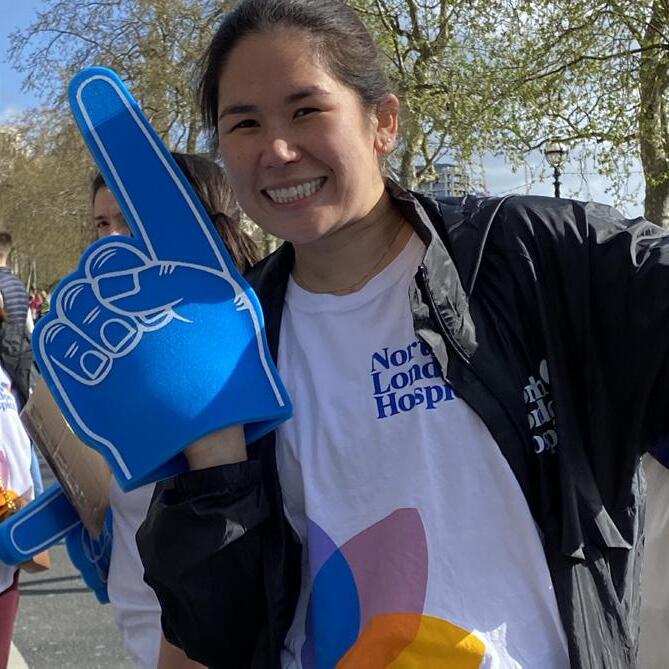
1302 attended our Big Fun Walk and together they raised a whopping £186K

Our Strategy and Ambitions
Our key Strategic Ambitions within our Strategic Plan are the driver for success and enable us to provide the best of life, at the end of life, for everyone, in the communities we support.
Our Vision
The best of life, at the end of life, for everyone
Our Purpose
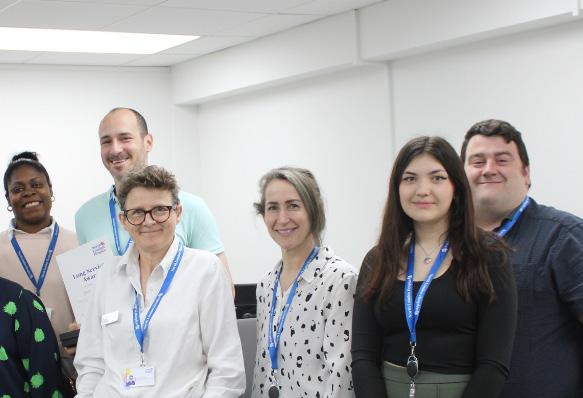
North London Hospice - working together to provide palliative care and support, when and where you need us most
Our Values
Collaborative and learning
Open and honest
Respectful and empowering
Equal and inclusive
Being at the hospice has been lifechanging for me. I couldn’t believe that such a concentration of goodness could exist in one place. (IPU Patient Feedback) “ ”
Contents
Our key Strategic Ambitions
Our Reach
We will drive innovation and deliver quality through everything we do
1
Our Duty
We will manage our charity efficiently and effectively to achieve long term sustainability
2
We will ensure outstanding care and support is at the heart of what we do, offering this across our community to those facing a life limiting illness. We will increase the number of people provided with personalised care through service and operational improvements, so that our hospice continues to play a vital role for the communities we serve. We will review services and support functions as appropriate, change models and delivery where necessary and develop new initiatives.
Our Commitment
We will value and support our staff and volunteers to do their jobs well
3
We are committed to ensuring financial stability and long-term viability, whilst investing for growth and development. We will manage our resources to ensure we achieve the greatest impact with our work in our community. We will work together in partnership, and in an integrated way to achieve our ambitions. We will transform communication and information sharing and deliver improved systems and ways of working with investment in technology.

We will recruit, retain, and invest in our people to be the best they can be. We will use our expertise and skills to improve, and deliver, the palliative care and support we pride ourselves on to more people across our community. We value equality, diversity and inclusion and will develop leadership and our workforce which is representative and responsive to the communities we support.
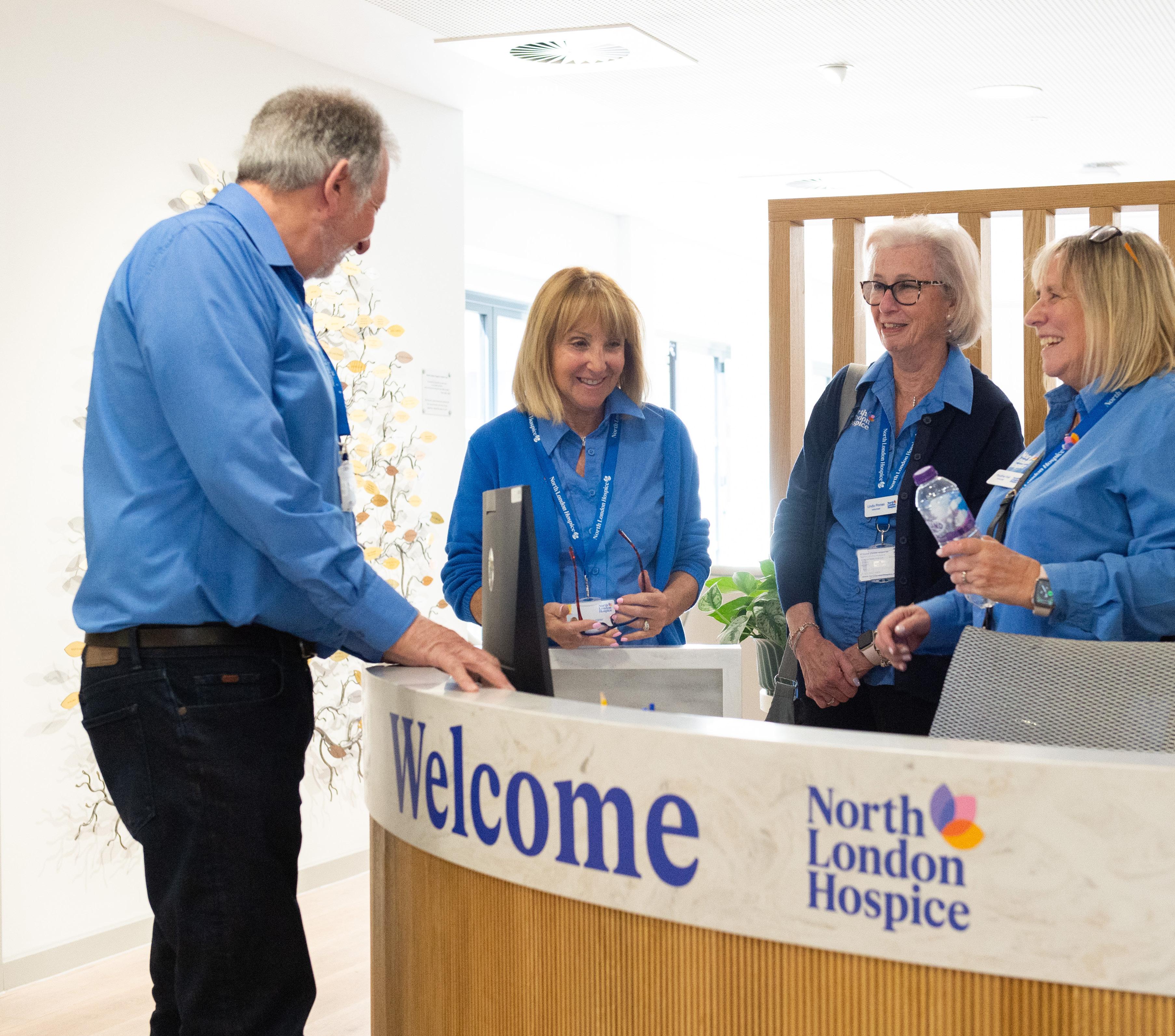
Thank you for all the time, effort, attention and kindness you have shown. It takes special people to do what you do and we want you to know it’s very much appreciated.
(Family of a patient in IPU) “ ”
Contents
Our Achievements for 2023/24:
AMBITION 1 – Our Reach
We will drive innovation and deliver quality through everything we do.
Strategic Objective: We will increase the number of people provided with outstanding, personalised care through all our services.
OUR 2023-24 AMBITION
We will develop and launch our 4-year clinical strategy to support our Strategic Plan.
We will increase the number of people we provide personalised care and support to each year by 5%.
We will review our Inpatient Unit and introduce new models of care and support to achieve greater impact.
WHAT WE ACHIEVED
We have completed a number of the workstreams in the clinical strategy. Evidencing our outcomes through completed tasks.
We have focused on expanding our reach and improving our productivity which has enabled us to have an 11.21% increase on last year.
We had an admission and discharge task force led by senior IPU leaders. This work improved the admission and bed management processes.
We implemented a fast-track escalation process to reduce delays and a bed occupancy escalation process to maintain as high level occupancy as possible.
We implemented training on Advance Care Planning for IPU staff and have seen the benefit of improvement in this area.
OUR 2023-24 AMBITION
We will listen to feedback from patients and relatives and adopt a culture of continuous improvement.
WHAT WE ACHIEVED
We developed our User Engagement Group, as part of the strategy. The group has oversight of strategic and operational issues relating to Patient Experience and User Engagement. The group share, learn and disseminate themes which impact our service users. It identifies and implements improvements, such as new training requirements and policy changes. We work in collaboration with all teams. The focus of the meetings is to hear from our service users about their lived experience and this enables us to improve and inform practice.
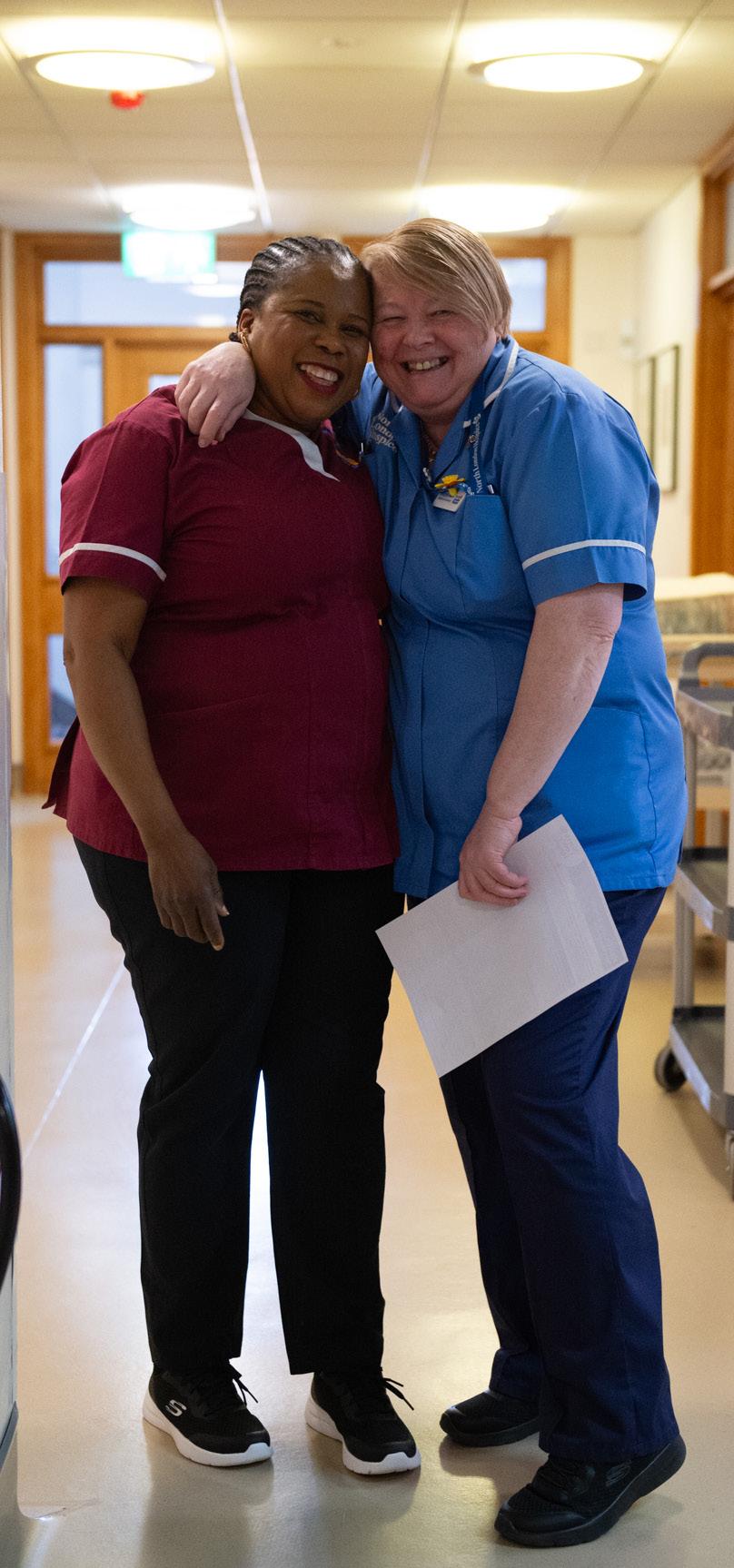
Through our quality improvement project related to complaints and concerns, we have increased openness and transparency around reporting. This meant that we saw an increase in complaints across 2023/24 and we view this as a positive step to improvement.
We worked closely with our Learning and Development team and we developed and delivered organisation wide interactive COREmunication training, which has improved communication service users receive from our staff.
We increased our feedback mechanisms, introduced digital surveying of our Retail operation, and used the information to understand quality of experience for our supporters and improve service.
We will expand our care delivered at home, in the community, our advice and other services through partnerships to offer 24-7 care and support to those who need it.
OUR 2023-24 AMBITION
We will deliver a range of outreach projects and clinics offering accessible information, and models of care and support on health and social care issues.
WHAT WE ACHIEVED
Following a review of our outreach services, we have a grief café; a co-produced service with the local community staff and bereaved relatives. The model is currently running in collaboration with Enfield libraries, and we will then review the impact of this model with a view to rolling out to others.
We will increase our support for bereaved people – we will partner with others to help us achieve this.
We implemented a tiered referral system to ensure those with the greatest need have immediate access to bereavement support whilst ensuring all those in need are provided with relevant information.
We will increase our knowledge of the palliative care needs of the communities in our area and adapt care, support, services and information to support them
OUR 2023-24 AMBITION
We will deliver on a Community Engagement Strategy reaching into our communities and promoting our work around Equality, Diversity & Inclusion.
WHAT WE ACHIEVED
This year we have been focused on improving our understanding of the death rituals and experience of the Traveller community. This has led to them being engaged within our education programme to increase the understanding of this group’s needs for our clinical staff.
We will review the data we collect and use greater analysis and outcomes to influence services and capacity and to increase income and impact across our charity.
We have worked collaboratively with ICB data analysts to contribute to a ‘Demand and Capacity’ tool. This is enabling us to improve our bed capacity as well as contribute to the ICB’s understanding of the overall demand for hospice beds in North Central London.
We have taken data that we had been sharing externally and created internal statistical process control run charts. This is enabling heads of service and team leads to better understand the fluctuations in demand and performance. It is also enabling a KPI report for the clinical governance and assurance committee and the Board.
We will use our knowledge and expertise to educate and train others.
OUR 2023-24 AMBITION WHAT WE ACHIEVED
We will work in partnership using our expertise, skills and knowledge to train others and help improve end-of-life care and support inside and outside the hospice.
We will participate in research where it supports our work and helps us deliver our strategic ambitions.
The hospice welcomed students and learners from several professions including nursing, physiotherapy and paramedics. Young learners, interested in a career in healthcare, were also welcomed into the hospice for a number of summer and autumn schools. Two cohorts of learners completed the European Certificate in Essential Palliative Care course that is run in partnership with 14 other hospices. Learners were welcomed from as far afield as India and Australia. A poster sharing the success of the preceptorship programme for the cohort of Trainee Nursing Associates was also accepted for display at the Hospice UK Conference.
Our Research Steering Group (RSG) has reviewed and redrafted our research policy and developed partnerships with the National Health Institute of research (NIHR) North Thames Clinical Research Network (CRN) team and their agile workforce team.
Four delegates from the hospice attended the research conference: harnessing the potential for hospices to deliver innovative research, an opportunity to network and learn within the sector.
A research strategy focusing on research culture, collaboration and creating working partnerships; enabling access to take part and contribute to research and developing the governance structure for research has been completed for 2024-27.
The hospice has taken part in two main studies: CHELsea (II) Trial - A Cluster Randomised Trial of Clinically Assisted Hydration in Patients In The Last Days Of Life. We opened as one of over 80 sites nationally and we have recruited 15 of the expected 20 patients. We have enrolled our clinical fellow in the National Institute for Health Research (NIHR) Associate Principal Investigator 26 (PI) Scheme working to support this trial- which will enable the development of research skills in our workforce.
We will participate in research where it supports our work and helps us deliver our strategic ambitions.
We will influence policy makers to appreciate, understand and respond to the needs of those living with a life-limiting illness.
NHS Blood and Transplant (NHSBT) - Eye Donation from Palliative and Hospice Care Settings: Investigating Potential, Practice, Preference and Perceptions (EDiPPPP). We were one of six hospices selected to participate in this pilot. To support a sustainable approach to eye donation, a Standard Operating Procedure (SOP) and an EMIS electronic record template for eye donation have been developed and implemented, alongside training for key staff. We have appointed three Eye Donation Champions in the nursing team on IPU who are leading the way amongst the nursing staff. Analysis of the pilot date is in progress following the end of the data collection period of end March 2024.
Our Chief Executive is a member of the Hospice UK Advisory Council and represents London at a national level. We have responded to several national campaigns to influence policy relating to end-of-life care.
We continue to have active dialogue with our partners, including Hospice UK, and our stakeholders from across the community.

AMBITION 2 – Our Duty
We will manage our charity efficiently and effectively to achieve long term sustainability.
We will invest in skills, expertise, and systems so we work and communicate more effectively.
OUR 2023-24 AMBITION
We will launch a new Communication, Marketing and Digital Plan, showing our commitment to making a positive difference.
WHAT WE ACHIEVED
We have been working fully to embed our new brand and tone of voice across all our assets. It has been very well received, especially on the high street across our retail estates. Work has started on improving our digital platforms and there will be investment in the coming year in our website and internal communications platforms.
We will deliver an IT Investment plan and longer-term strategy to ensure we have the key operating tools to deliver innovation, support patients, assistive technology and deliver our strategic ambitions.
We started a re-tender of the existing IT support contract, with the aim of building on some of the successes over recent years. Cyber Essentials Plus was achieved for the first time by the Charity and we are keen to meet and exceed existing compliance and regulatory requirements. The new provider has started and will provide additional enhanced resources covering our 24/7 service offering.

We will implement and deliver on an Income Generation strategy to support the delivery of our strategic ambitions.
OUR 2023-24 AMBITION
We will appraise all our portfolio of retail outlets and deliver a clear retail strategy that represents an optimum return on investment – increasing our retail income by at least 25% over the next 4 years.
WHAT WE ACHIEVED
During the year we reviewed our retail strategy and the Board invested in a new role as Director of Retail – the postholder starts on 1st July 2024. We worked in partnership with the Charity Supermarket (charitysupermkt.com) to participate in a number of new initiatives such as a pop up store at Brent Cross and Westfield and car boot initiatives at Kings Cross – bringing great exposure around our work and increased revenue.
We will increase fundraising income by at least 25% over the next 4 years by growing our fundraising activity, including investing in growth where it delivers a key return on investment.
We will deliver on our long-term Financial Strategy to achieve a balanced budget by 2025.
We completed the first year of our fundraising strategy and saw a significant increase in fundraised income this year. We have been investing in testing new products and activities to appeal to many different audiences, including Big Fun Craft, Big Fun Step and Forever in our Hearts. We have also sent out three door drop campaigns to attract new supporters to the hospice which has been successful this year.
A revised plan to deliver a balanced budget within three years was agreed by the Board in 2023. The charity has budgeted a deficit of £0.9m in 24/25 as it moves towards a balanced budget by 2027.
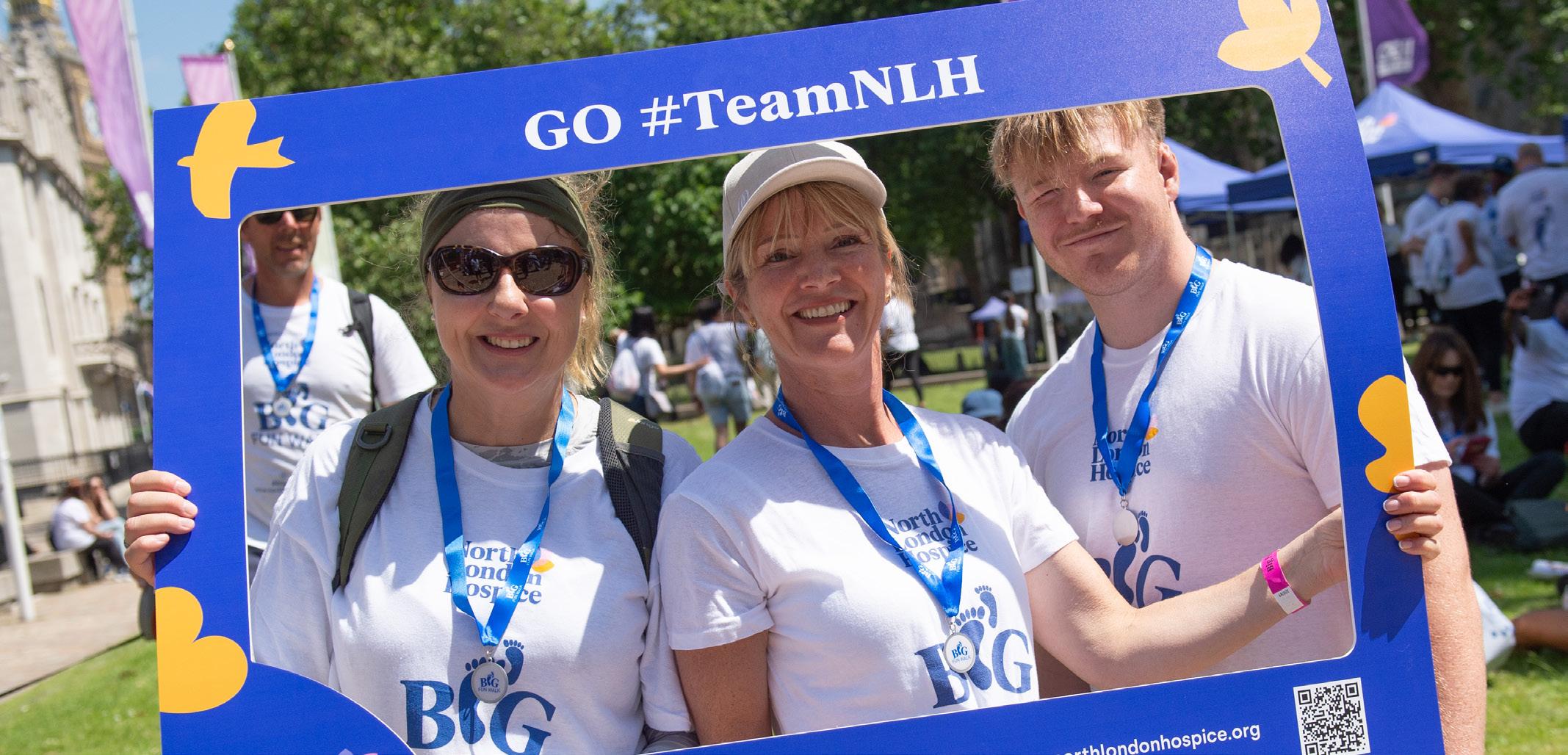
We will transform our hospice through investment, growth, and development.
OUR 2023-24 AMBITION
We will build organisational resilience through investment in our infrastructure.
WHAT WE ACHIEVED
Our Trustees have agreed to establish an IPU Transformation Project Board, to examine and appraise an IPU refurbishment project and work is underway looking at design options and feasibility. We have started to examine a capital appeal, and subject to due diligence and approval this will be launched in 2024. This will see plans to transform our Inpatient Unit with state-of-the-art accommodation and services over the next few years.
We will ensure our governance framework supports assurance and compliance and our commitment to be the best we can.
Our Board, through a recruitment campaign, appointed several new Trustees in the year, bringing with them a range of complementary skills to strengthen our Board further. We will be introducing new advisor roles in 2024. We conducted a governance review with DigiBoard and are taking forward the recommendations to strengthen and improve our approach to governance.
We will innovate, engage, and actively respond to opportunities for working, sharing, and learning from each other
OUR 2023-24 AMBITION
We will lead on partnership and collaboration with commissioners, providers, and suppliers, shaping how we design and deliver our clinical, patient, and other services that meet local need and have real impact.
WHAT WE ACHIEVED
National Institute for Health Research (NIHR) North Thames Clinical Research Network Agile Nursing team- to support CHELSea II research trial delivery on our Inpatient Unit and development of research at North London Hospice.
NHS Blood & Transplant (NHSBT) Tissue and Eye Services we have worked with the team to deliver the eye donation pilot project which has supported development and education of Inpatient Unit staff and ultimately corneal donation.
OUR 2023-24 AMBITION
We will lead on partnership and collaboration with commissioners, providers, and suppliers, shaping how we design and deliver our clinical, patient, and other services that meet local need and have real impact.
Contents
WHAT WE ACHIEVED
We developed and recruited to two newly designed consultant posts which will work across Barnet Hospital and our Barnet and Enfield Community teams.
We actively work with North Middlesex University Hospital NHS Trust and Central London Community Health Care NHS Trust who also support the employment and provision of consultants working across our services.

We have worked with Enfield libraries to gain proof of concept for a Grief Café. This has been a co-production piece with staff and family members. This was led by the Bereavement Lead and will be supported in the future by volunteers. This year our contribution for Dying Matters Awareness Week will be a unique partnership with Chicken Shed theatre, bringing conversations about death and dying to two of the most deprived wards that we care for. This is an opportunity to open the conversation with people who are much less likely to access our services.
We partnered with Wild in Art to bring North London’s first art trail.
We collaborated with University College London (UCL) MSc students on a web app design. The app compared population data from the 2001 census with SNOMED (diagnosis) codes for ethnicity, age, cancer or non-cancer across our three boroughs, Barnet, Enfield and Haringey, with the ethnicity demographic of patients we care for. This data has been important in helping us to ensure our services are catering to the demographic of patients we serve in our community. This collaboration has been shared with NHSE and will be rolled out to other hospices to enable them to adapt their services more responsively.
Hospice Care Week event with Jewish Care. New partnership projects such as Chickenshed, Haringey Supporting Housing, Enfield Community Hubs and Libraries, Black Heritage Hub.
Member of 15 borough-wide council and volunteer community sector forums.
Joining culture celebration events, open days, information stalls, school career days, talks to community groups and 1-1s.
We will reduce our carbon footprint and environmental impact
OUR 2023-24 AMBITION
We will reduce waste by printing less, recycling more in the office and in our shops, and adopting greener procurement policies.
WHAT WE ACHIEVED
The new Paper Cut system has led to a reduction in printing as well as a new finance system leading to a near paperless accounting office, saving 5,000 sheets of paper annually. We sold 734,385 items in our shops, building on our pledge to reach a target of one million items sold in 2024/25.
We will look at measuring our energy and carbon use and delivering an annual reduction of 10%.
During 24/25 we will continue to monitor our energy usage and assess where efficiencies can be achieved. We have fixed the supply costs for two years to ensure financial certainty in supply, with the focus now shifting to improving overall efficiencies. We will explore the installation of solar panels at Head Office in 2024/25 to achieve further energy efficiencies and savings. As part of our refurbishment programme we have installed sensor lighting in various areas of the hospice reducing energy consumption. Swipe card printing has drastically reduced paper wastage.
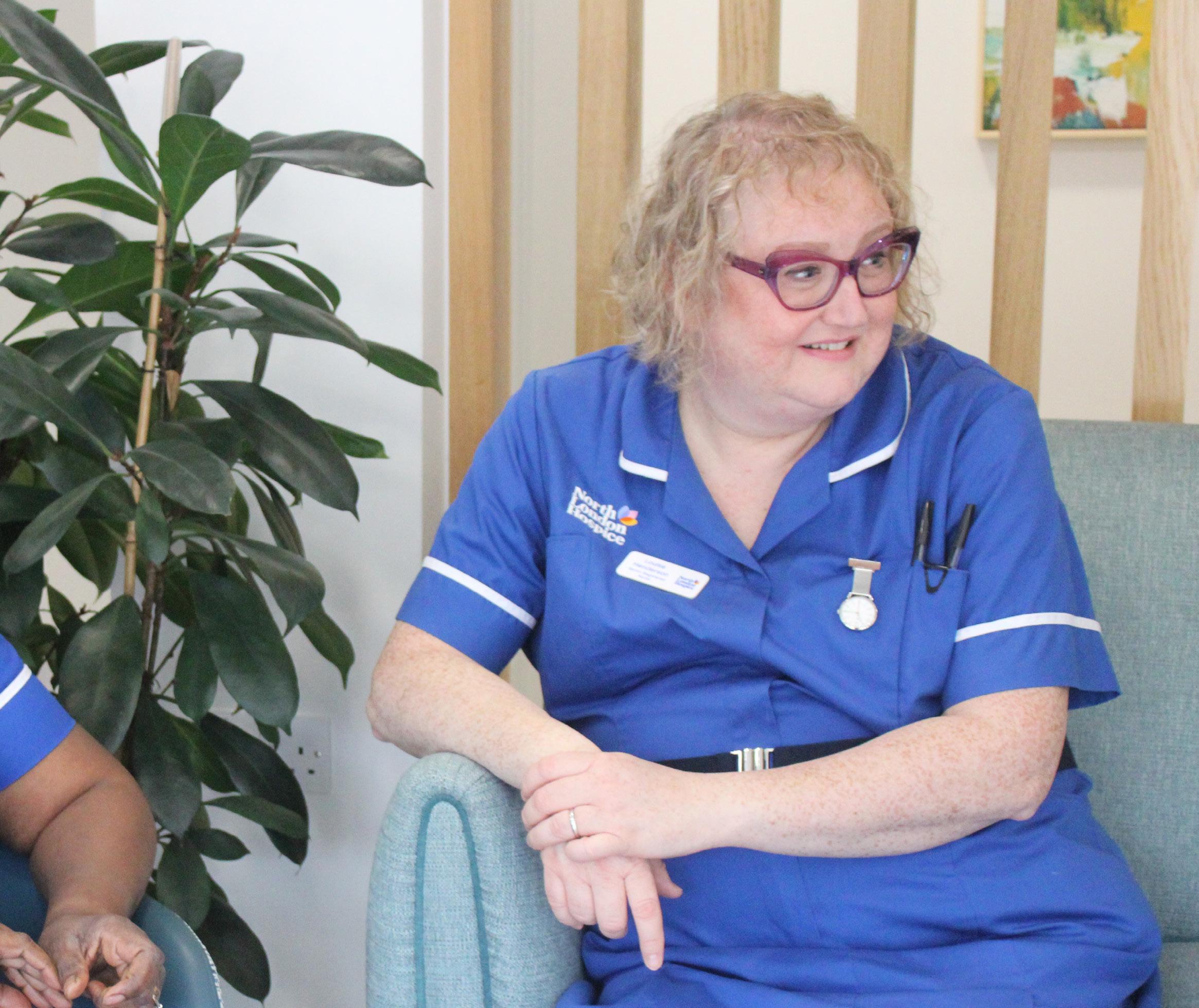
We will value and support our staff and volunteers to do their job well.
We will continue to provide our staff and volunteers with enjoyable and rewarding experiences to be the best they can.
OUR 2023-24 AMBITION
We will publish and deliver on a new people strategy which transforms us from a ‘good’ to a ‘great’ organisation to work or volunteer for – promoting wellbeing for all.
WHAT WE ACHIEVED
We have implemented a new staff engagement platform Winning Temp which tracks employee engagement and wellbeing through fortnightly pulse surveys. Live ‘temperature’ data from across the organisation is being used to identify priorities for action at team and organisational level as part of a continuous cycle of improvement in our people practice.
We have continued to build our wellbeing resource library for volunteers which can be accessed online and continued to provide reflective space for patient facing volunteers.
We will review our staff terms and conditions and launch a new rewards package ensuring it continues to be attractive, affordable, and positively positioned in the market, to be an employer of choice.
We will review, develop, and implement improved processes to understand what works best for our existing staff and volunteers, and what could be improved to support retention.
We have used our new job evaluation system to analyse and grade new jobs.
Developing work on our organisational values a group of managers produced a guide to living our values, putting our patients at the heart of all we do. This has now been published and shared with all staff, and we are integrating with recruitment and performance management, as well as continuing our values awards to celebrate staff who our living our values.
We have undertaken some system improvement activity regarding Staff Care with the system provider to ensure we are making better use of the system, streamlining a number of our processes to improve efficiencies and provide better management information.
We have streamlined the volunteer onboarding process to cut down the length of time between volunteer application and start date.
We have scoped alternatives to our volunteer management system (VMS) looking at how we can align staff and volunteer management. We have made changes to the way we use our current VMS to improve reporting.
OUR 2023-24 AMBITION
We will continue to train and develop our own professional workforce to deliver the highest level of quality and outstanding service.
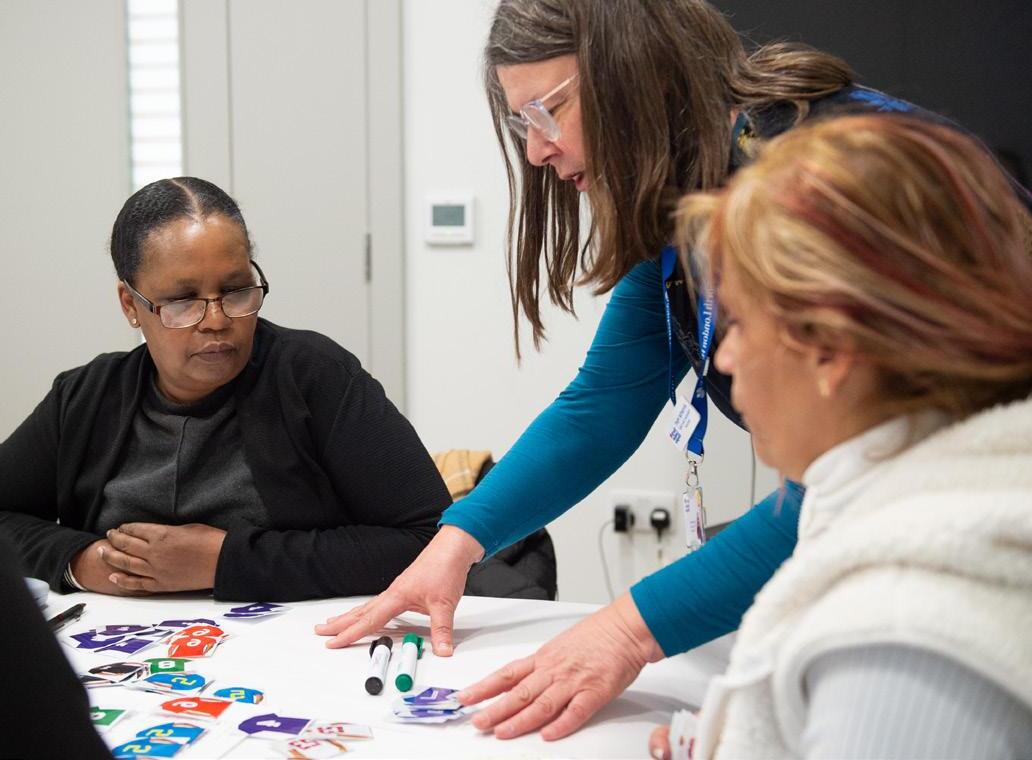
WHAT WE ACHIEVED
A new e-learning training system was implemented and in addition to e-learning, staff were offered a number of internal training opportunities. Courses included psychological training, Cognitive Behavioural Therapy, non-invasive ventilation, and Motor Neurone Disease.
The Learning & Development team also continued to directly mentor clinical team members, offer reflection opportunities, and lead staff away days to develop ideas and change practice.
A staff conference was also held in May, with 135 staff attending.
The team continued to support several apprentices in both non-clinical and clinical areas. Current apprenticeships offered by the hospice include fundraising, data analysis, leadership, social work and a Registered General Nurse top up degree.
Mandatory training for volunteers is now being uploaded to the VMS so that volunteers can do it in their own time. Compliance is now over 90%.
We will develop our leaders to not only look at performance and strategy, but also at what they can do to energise and motivate their teams to be their best.
The Executive Team have engaged in a series of externally facilitated team coaching sessions to ensure new directors integrate into the team, new ways of working are established, and values become embedded in our leadership.
The approach has been extended to the Senior Management Group, focusing on an actionlearning approach.
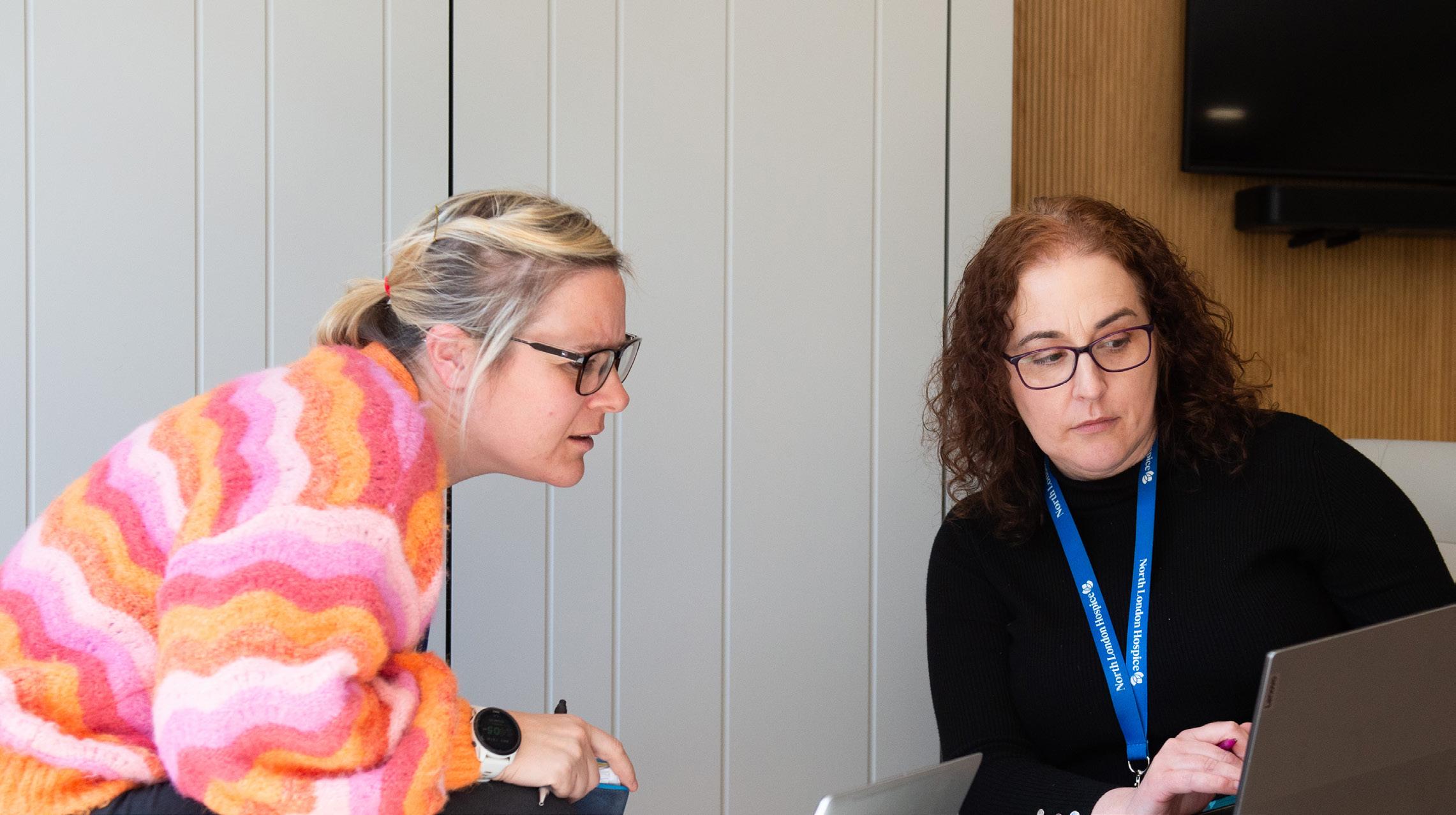
OUR 2023-24 AMBITION
We will create a positive culture throughout North London Hospice, where diversity, inclusion and respect are core values and at the centre of all our activities and enable us to widen our reach and diversity in terms of staff, volunteers, and patients.
Contents
WHAT WE ACHIEVED
There has been a lot going on to improve and encourage a diversity and inclusion culture throughout the hospice.
Count Me In - Relaunched our staff campaign in July 2023, with a staff video, FAQs, and articles on the intranet. By October 2023, we had received 61% of our staff demographic data, an increase of 17% on our previous rate.
A Survey Monkey campaign was run with retail volunteers to capture ED&I data, and 50 responses were received.
Marked numerous dates within our ED&I Calendar, including International Women’s Day (March), Mental Health Awareness Week (May), Black History Month (October) and International Day of People with Disabilities (December).
The hospice was recognised as a Disability Confident employer.
A script for clinical staff to use when requesting diversity data from patients, was approved by the Medical Director.
British sign language, bite size training for staff, created in conjunction with a local school was rolled out.
Our clinical staff received training on LGBT+ inclusive palliative care, from Keech Hospice Luton.
We will ensure we train the best to be the best
We will continue to train and educate our staff, volunteers and ambassadors and explore how we can share our experience locally and nationally, across the NHS and within other organisations.
Training opportunities for external learners included local care homes who received training on subjects such as symptom management, verification of expected death and communication skills. Feedback included: “I would like to thank the organisers, the most exceptional lectures / presenter of the training, you all are amazing. Attending this training has further broadened my skills, knowledge, and confidence caring for palliative patients.”
Mandatory training was delivered to 87 volunteers either face to face or by Zoom and corporate induction was delivered to 35 new volunteers.
OUR 2023-24 AMBITION
We will explore, invest, and establish a learning and development service that delivers education inside and outside of North London Hospice, where there is a positive return on investment, adds value to our work and optimises income opportunities.
WHAT WE ACHIEVED
A learning and development framework that sets out the education and training that all staff require to fulfil their role effectively in both clinical and non-clinical roles has been developed and roll out will begin April 2024. The framework is research based and will demonstrate the steps the hospice takes to ensure staff are competent and able to give high quality care and follow best practice. The framework will also enable training to be appropriately costed to enable staff to have allocated time to undertake training. It will ensure equity in the allocation of training across the hospice and provide guidance for managers on training and development requirements, and training opportunities available to help identify career progression requirements.
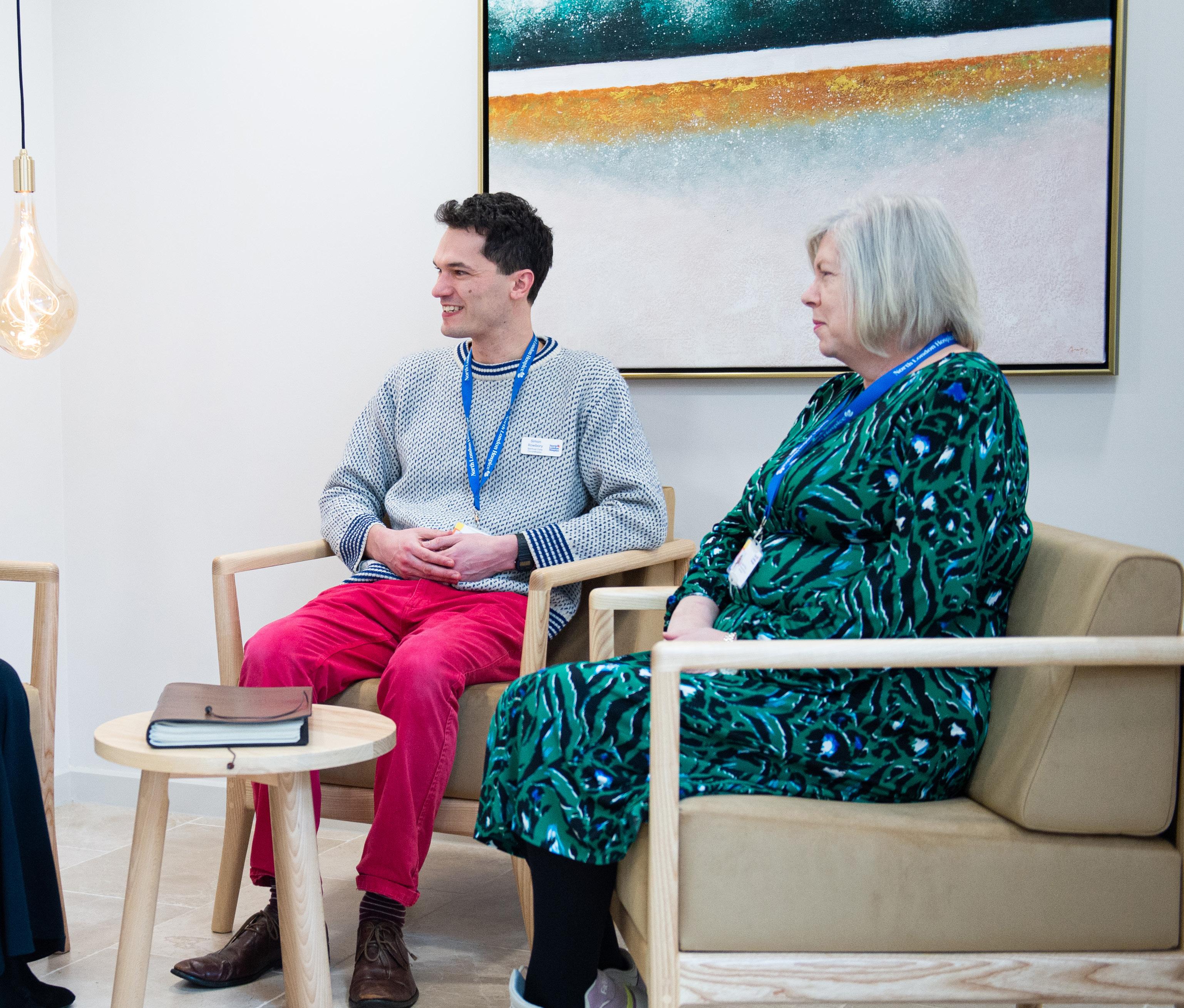
ContentsOur objectives for 2024-25
Our Reach
We will drive innovation and deliver quality through everything we do.
STRATEGIC OBJECTIVE 1
We will increase the number of people we support by providing outstanding, personalised care and support through all our services.
How do we plan to achieve this?
We will review and relaunch our new three-year Clinical Strategy to support our Strategic Plan.
We will increase the number of people we provide personalised care and support to each year by 5%.
We will launch our new Care Co-ordination Centre, responding to demand, using a more integrated approach to achieve greater impact and utilising innovative pathways and technology.
We will plan and deliver on our Inpatient Unit Transformation Project to deliver a redeveloped unit designed for 21st century care and support.
We will launch a new integrated 24-7 Community Services – extending our reach with new models of care and support and new ways of virtual and digital working.
We will deliver increased support for bereaved people – we will partner with others to help us achieve this.
We will deliver a community engagement plan focussing on outreach services into our communities and promote our work around Equality, Diversity & Inclusion.

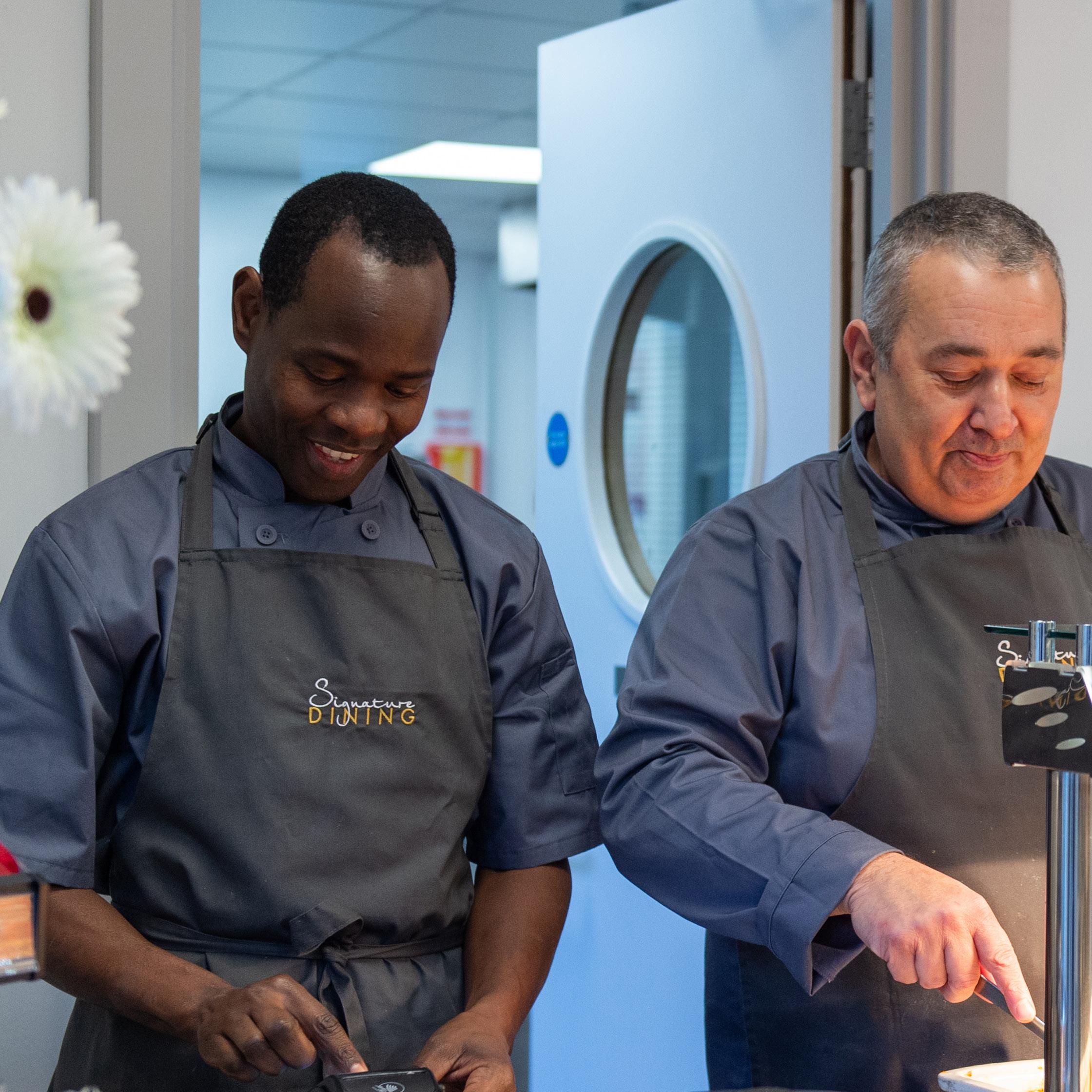
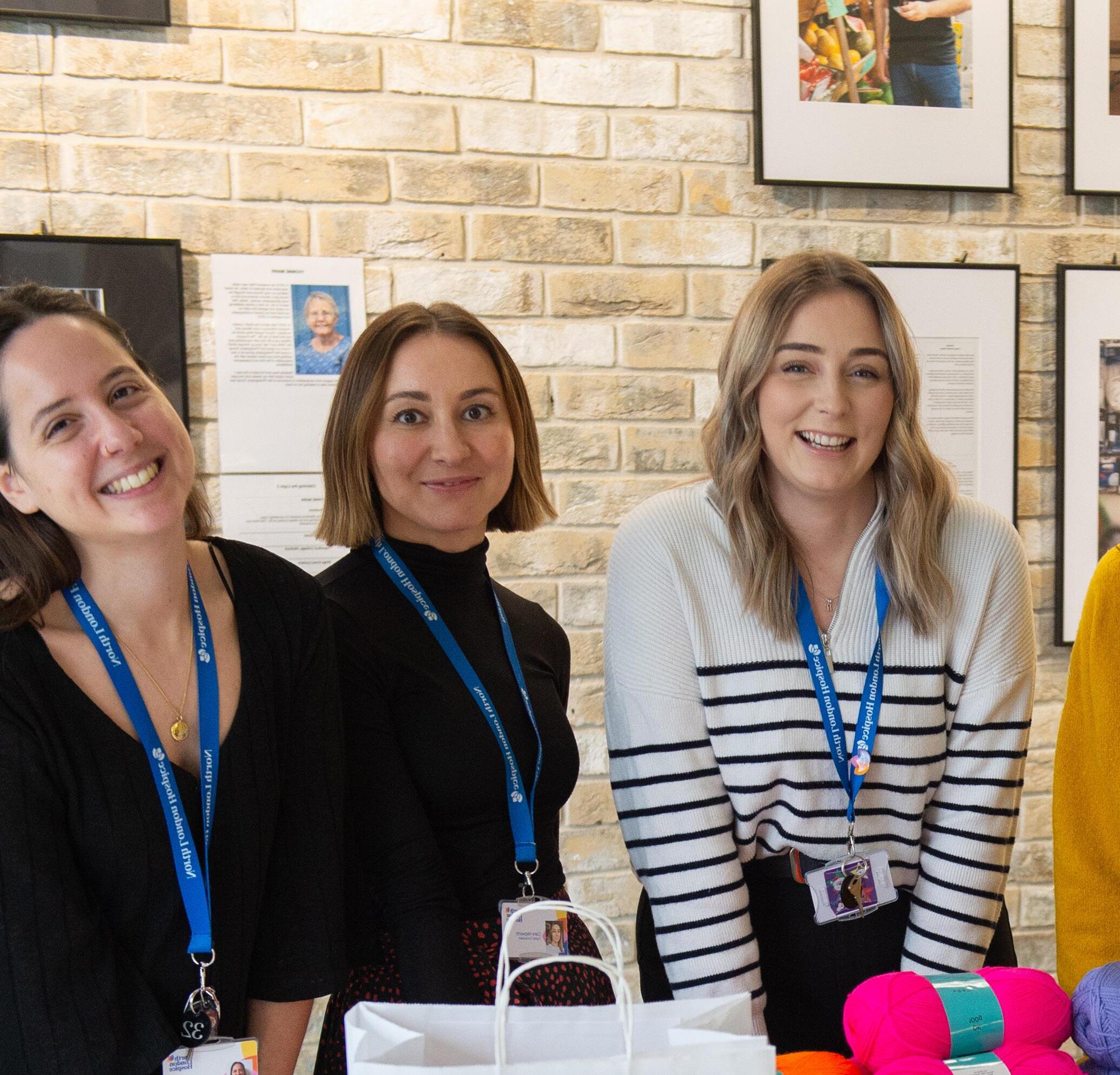
STRATEGIC OBJECTIVE 2
Contents
We will use our knowledge and expertise to educate, train and influence others.
How do we plan to achieve this?
We will work in partnership using our expertise, skills, and knowledge to train others and help improve end of life care and support inside and outside the hospice.
We will participate in research where it supports our work and helps us deliver our strategic ambitions.
We will influence policy makers to appreciate, understand, and respond to, the needs of those living with a life-limiting illness.
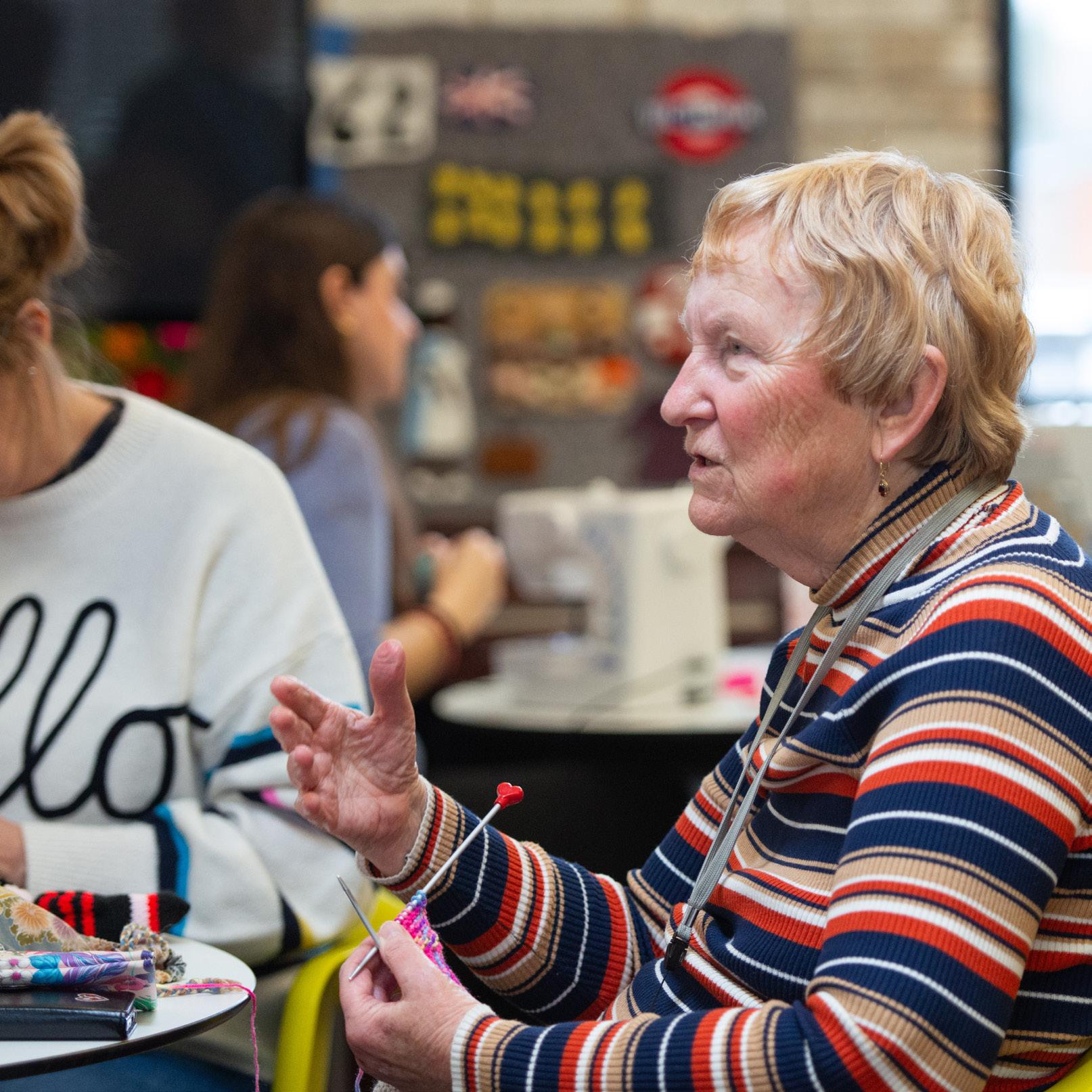
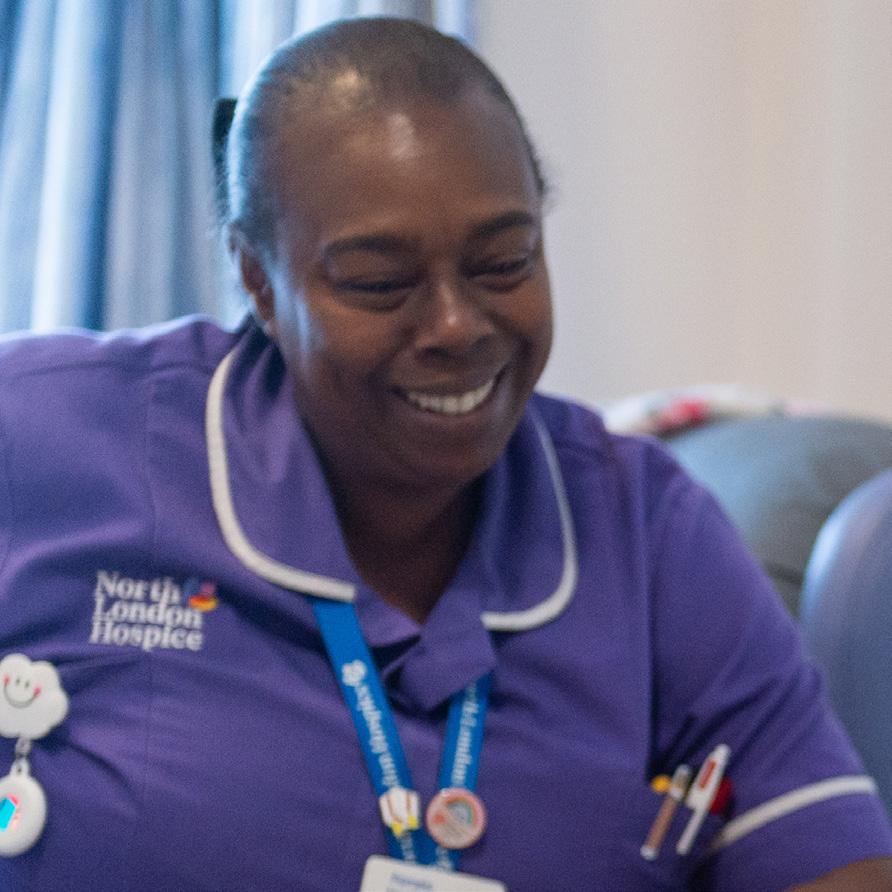
We will manage our charity efficiently and effectively to achieve long term sustainability.
STRATEGIC OBJECTIVE 3
We will invest in skills, expertise, and systems so we work and communicate more effectively.
How do we plan to achieve this?
We will review the data we collect and use greater analysis and outcomes to influence services, capacity, increase income and impact across our charity.
We will invest in our workforce and digital infrastructure to ensure that we work with and communicate effectively with everyone.
We will deliver an IT strategy and investment plan to ensure we identify new digital solutions to support efficiency and impact to deliver innovation.
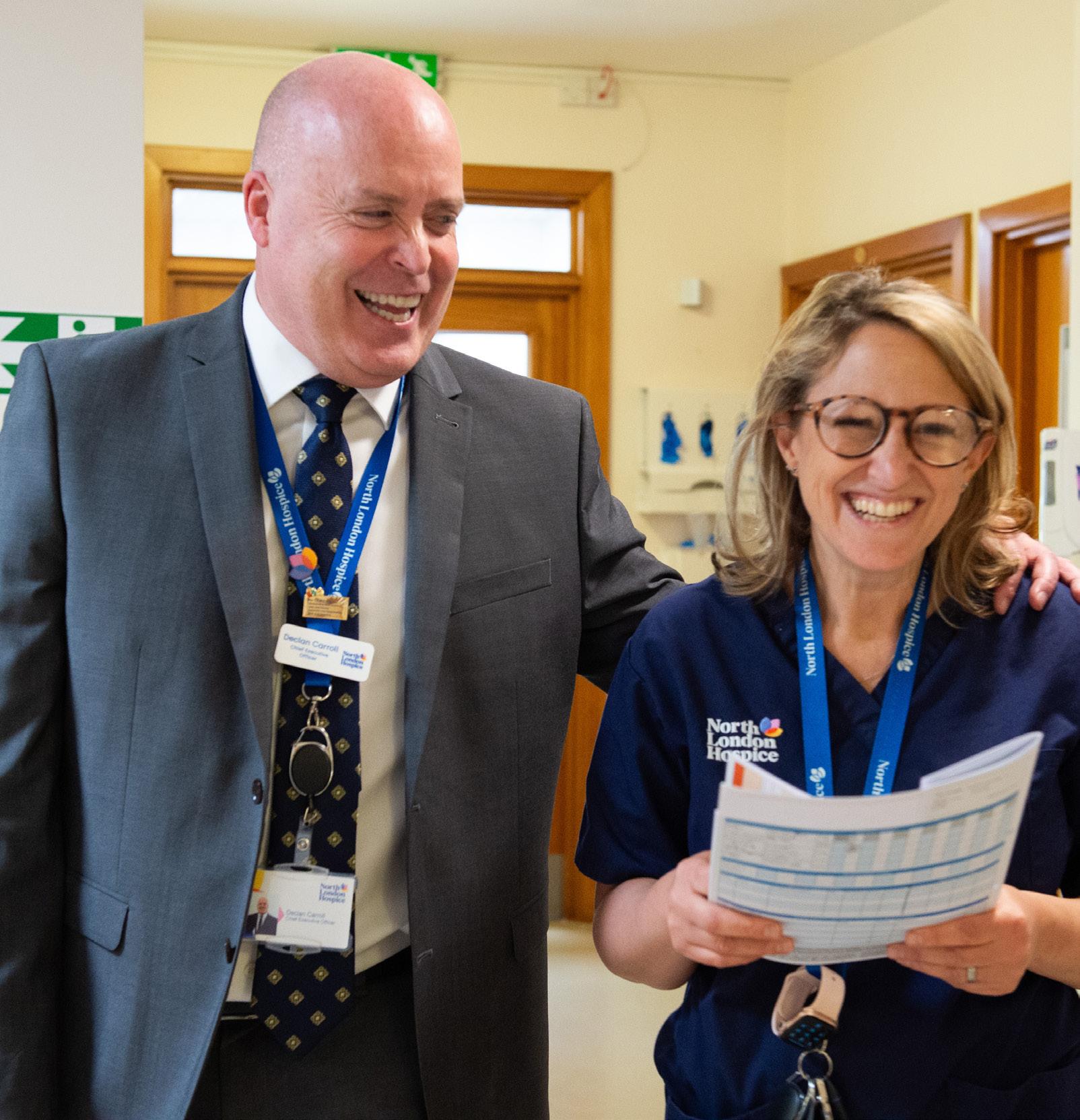
We will implement and deliver on an Income Generation strategy to support the delivery of our strategic ambitions.
How do we plan to achieve this?
We will appraise our portfolio of retail outlets and deliver a clear retail strategy that represents an optimum return on investment – increasing our retail income by at least 25% by 2027.
We will increase fundraising income by at least 25% over the next three years by growing our fundraising activity, including investing in growth where it delivers a key return on investment.
We will deliver on our long-term Financial Strategy to achieve a balanced budget by 2027.
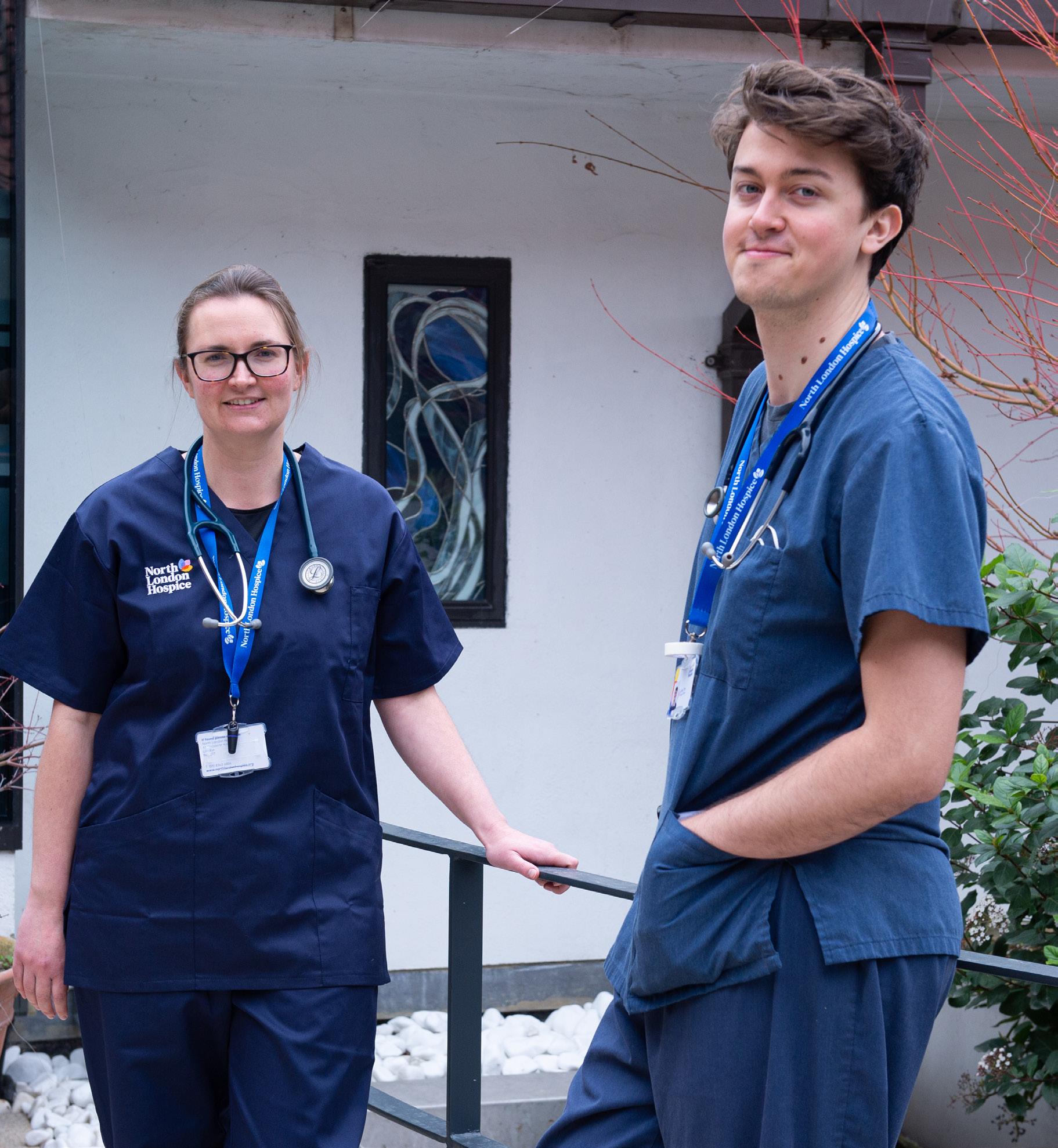
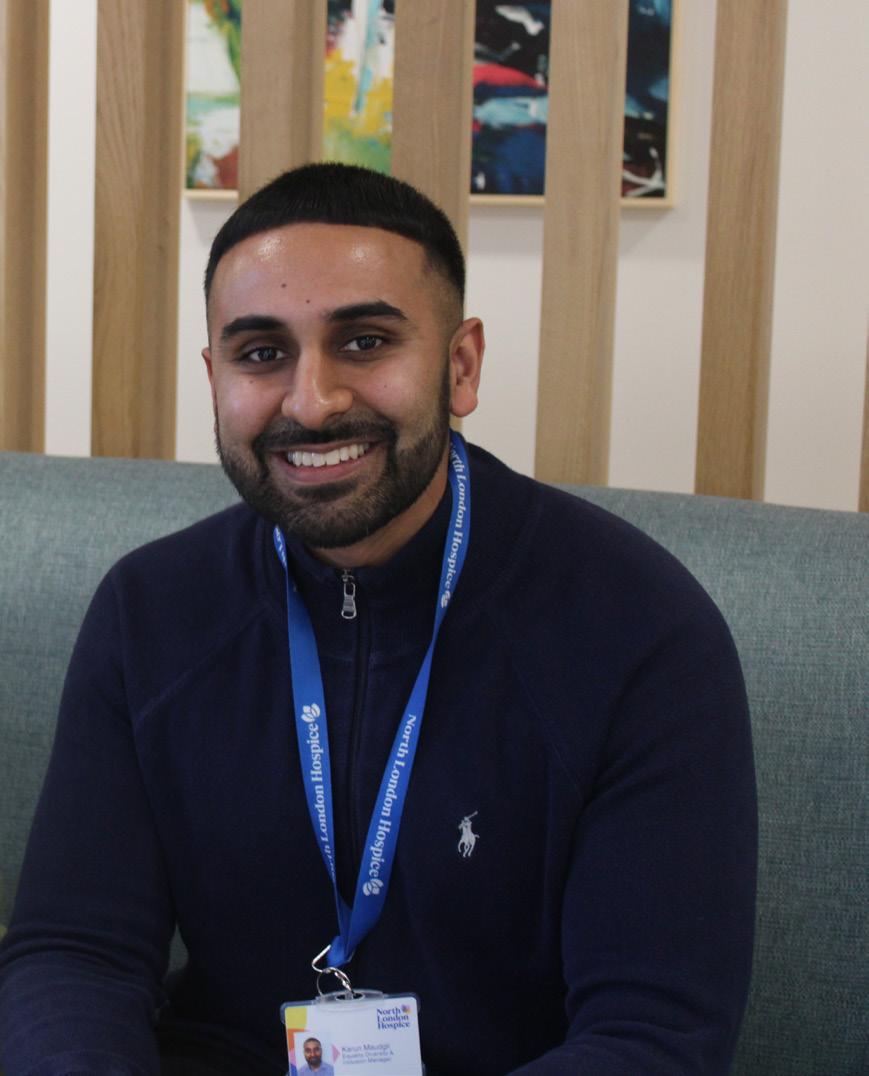
We will transform our hospice through partnerships, investment and our commitment to sustainability and environmental impact.
How do we plan to achieve this?
We will lead on partnership and collaboration, shaping how we design and deliver our services that meet local need and have real impact.
We will pilot several new service initiatives to test concepts that demonstrate impact and sustainability.
We will reduce waste by recycling more in the offices, and in our shops, and developing and adopting a new sustainability plan across all our operations.
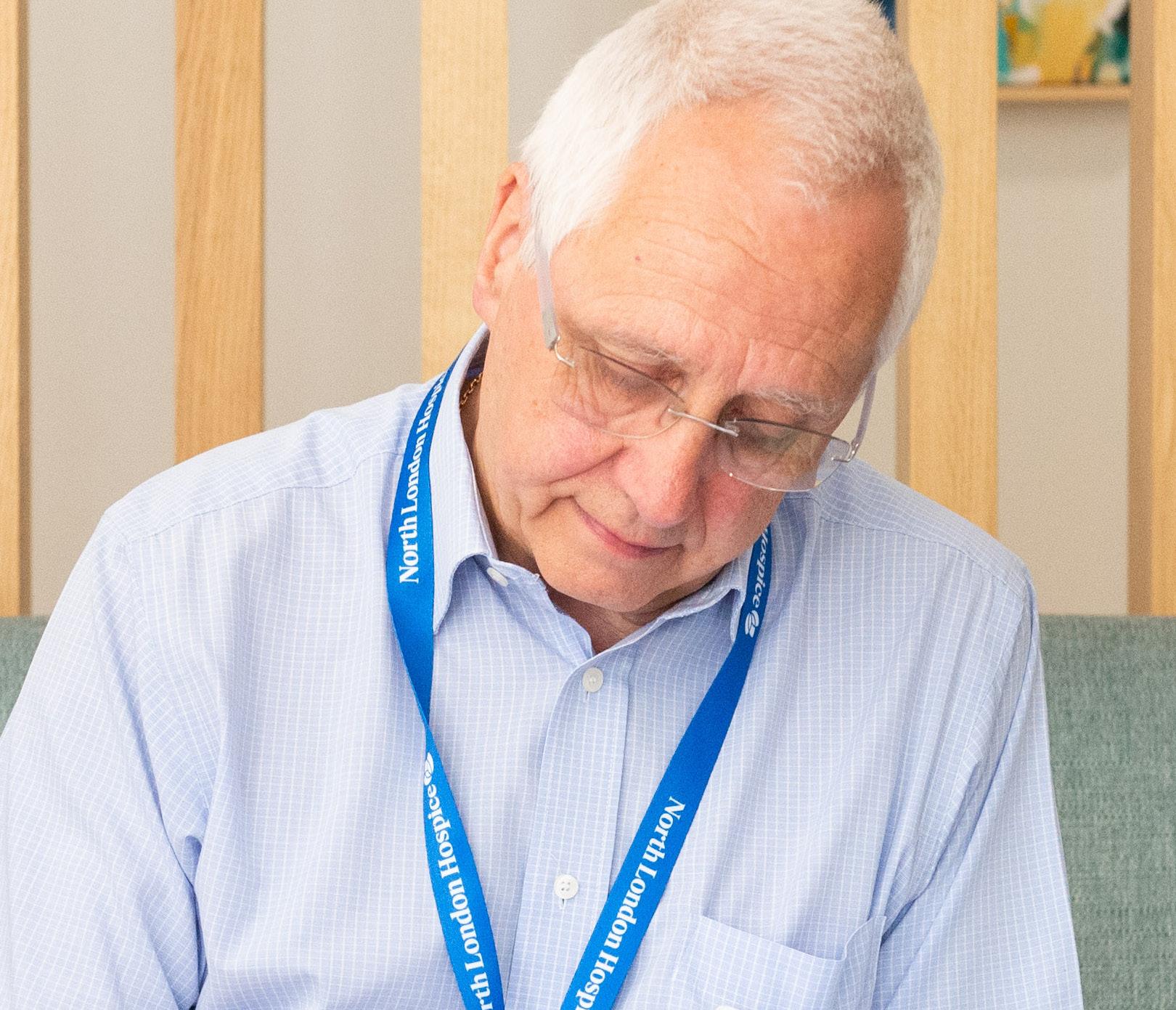
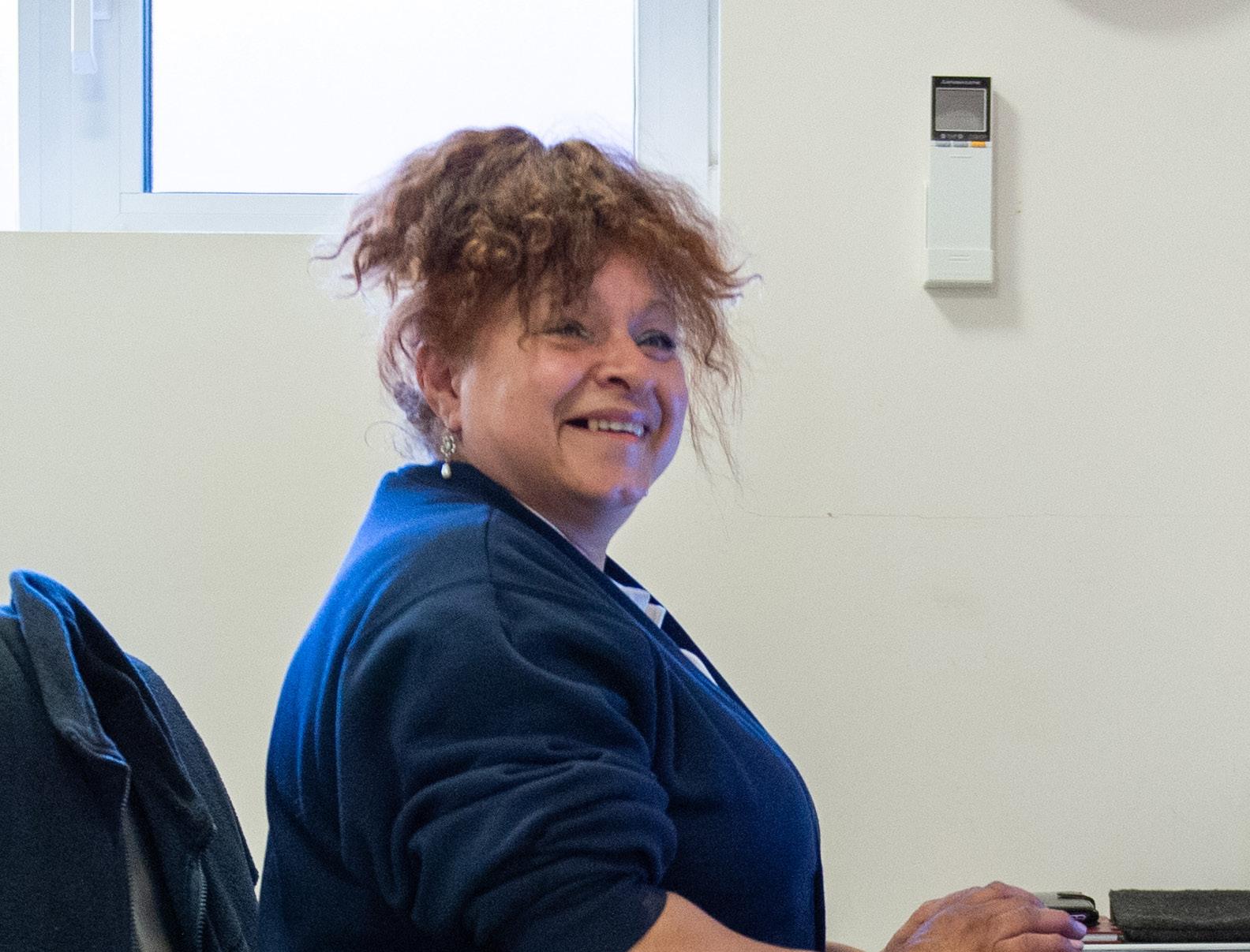
Our Commitment
Contents
We will value and support our staff and volunteers to do their jobs well.
STRATEGIC OBJECTIVE 6
We will provide our staff, volunteers and Trustees with enjoyable and rewarding experiences to be the best they can.
How do we plan to achieve this?
We will develop a long-term people strategy which transforms us from a ‘good’ to a ‘great’ organisation to work or volunteer for – promoting wellbeing for all.
We will launch and deliver a new Learning & Development framework to ensure our workforce provide the highest level of service to everyone.
We will develop our leaders to not only look at performance and strategy, but also at what they can do to energise and motivate their teams to be their best.
We will create a positive culture, where diversity, inclusion and respect are core values and at the heart of all our activities.
We will review our approach to supporting volunteers and launch a new strategy to help recruitment and retention.
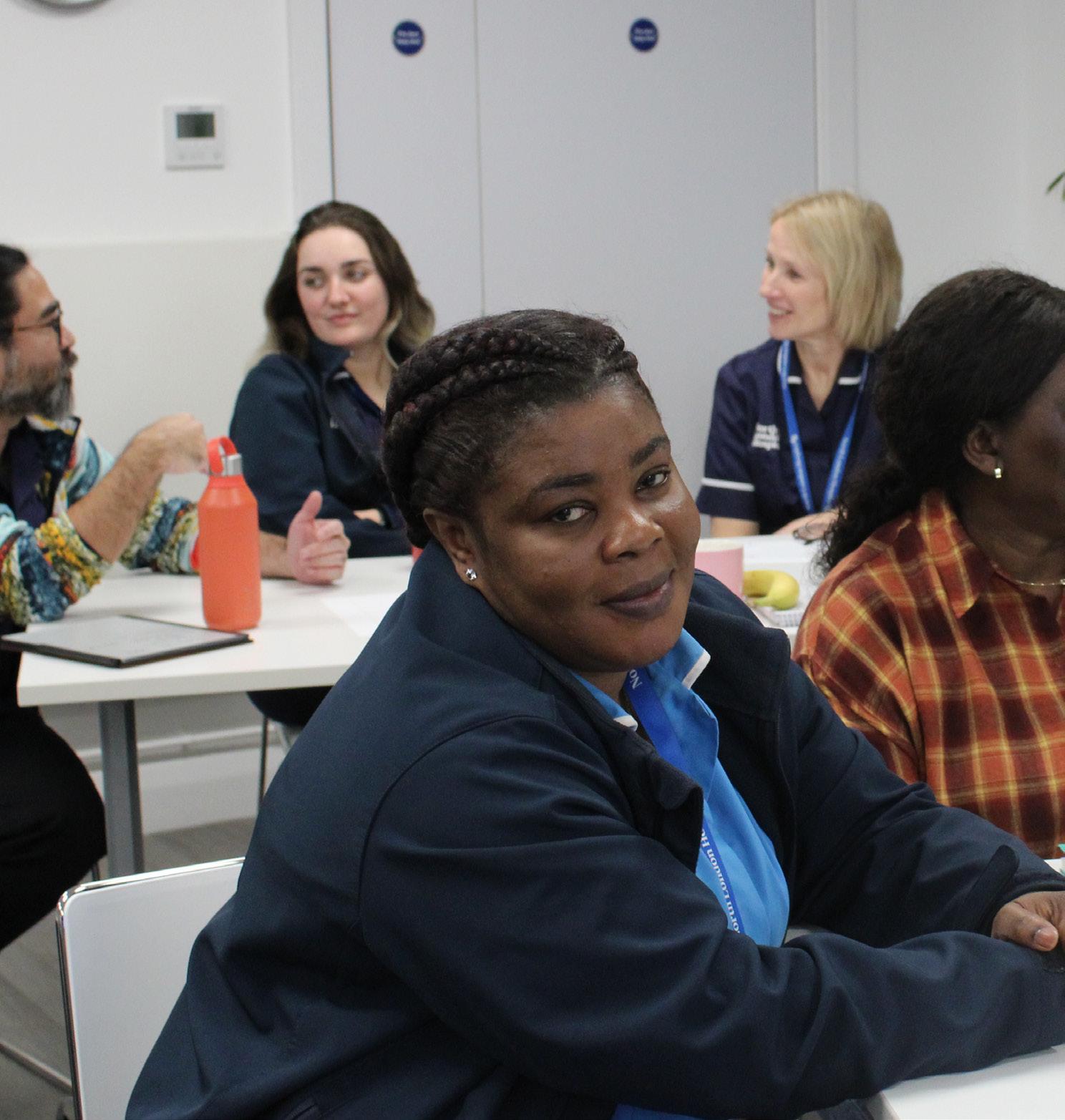
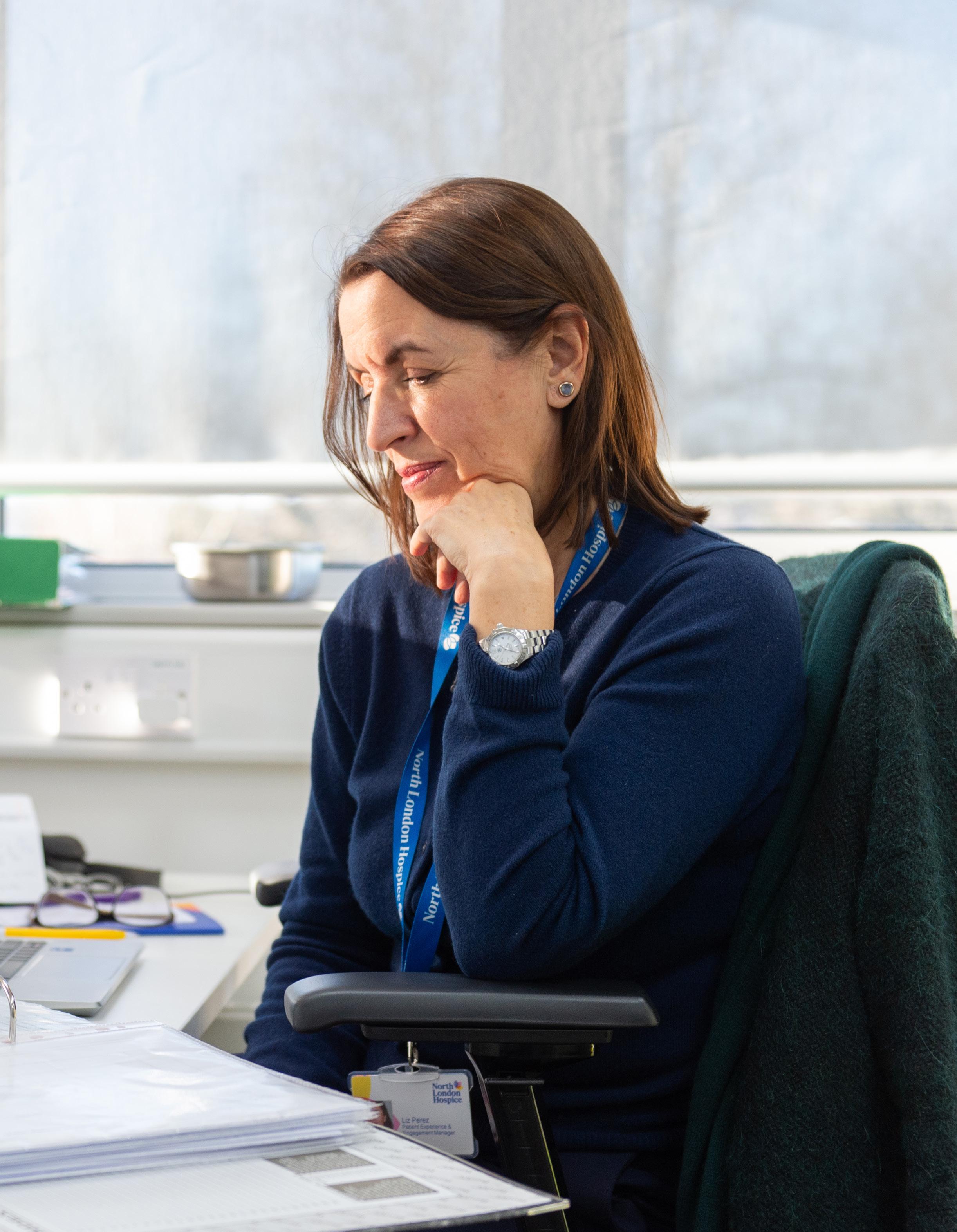
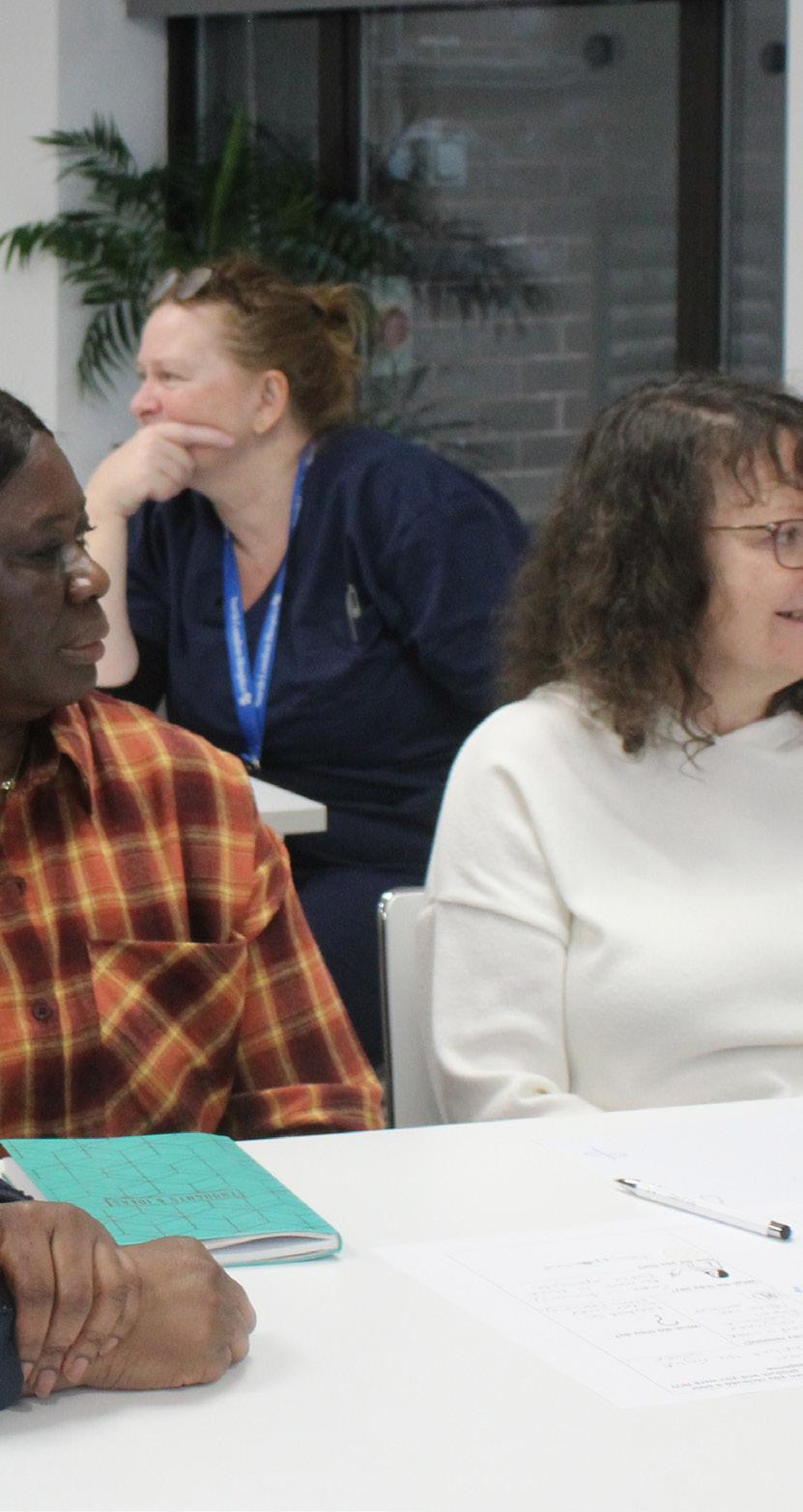
Patient Experience
We welcome all feedback to better understand the patient experience. We found that the overarching themes in compliments included the kindness, compassion and empathy of staff, outstanding communication of clinical staff and excellent holistic care for both patients and carers.
“The best way for me to describe the hospice is that it’s my lifeline. I have been unwell in the night and know I can always call and someone will be there for me.”
“Without any exaggeration, I thank God every day that I am here. It is a very special place; an oasis.”
“Before I came here, I was scared. I thought it was where you came to die, but it’s also about living better. I was really struggling until the palliative team became involved and don’t think I’d have got through the last few months without them.”
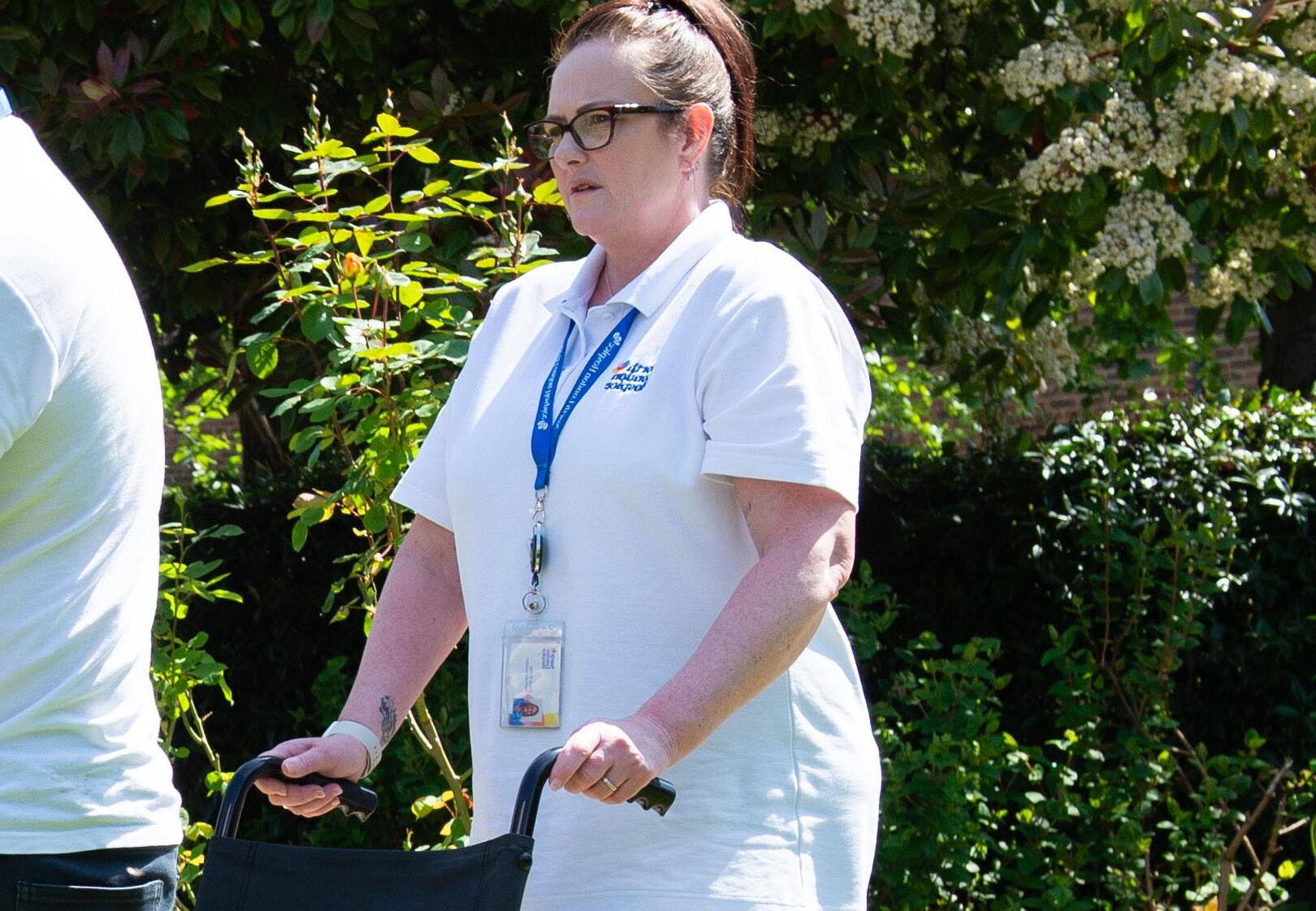
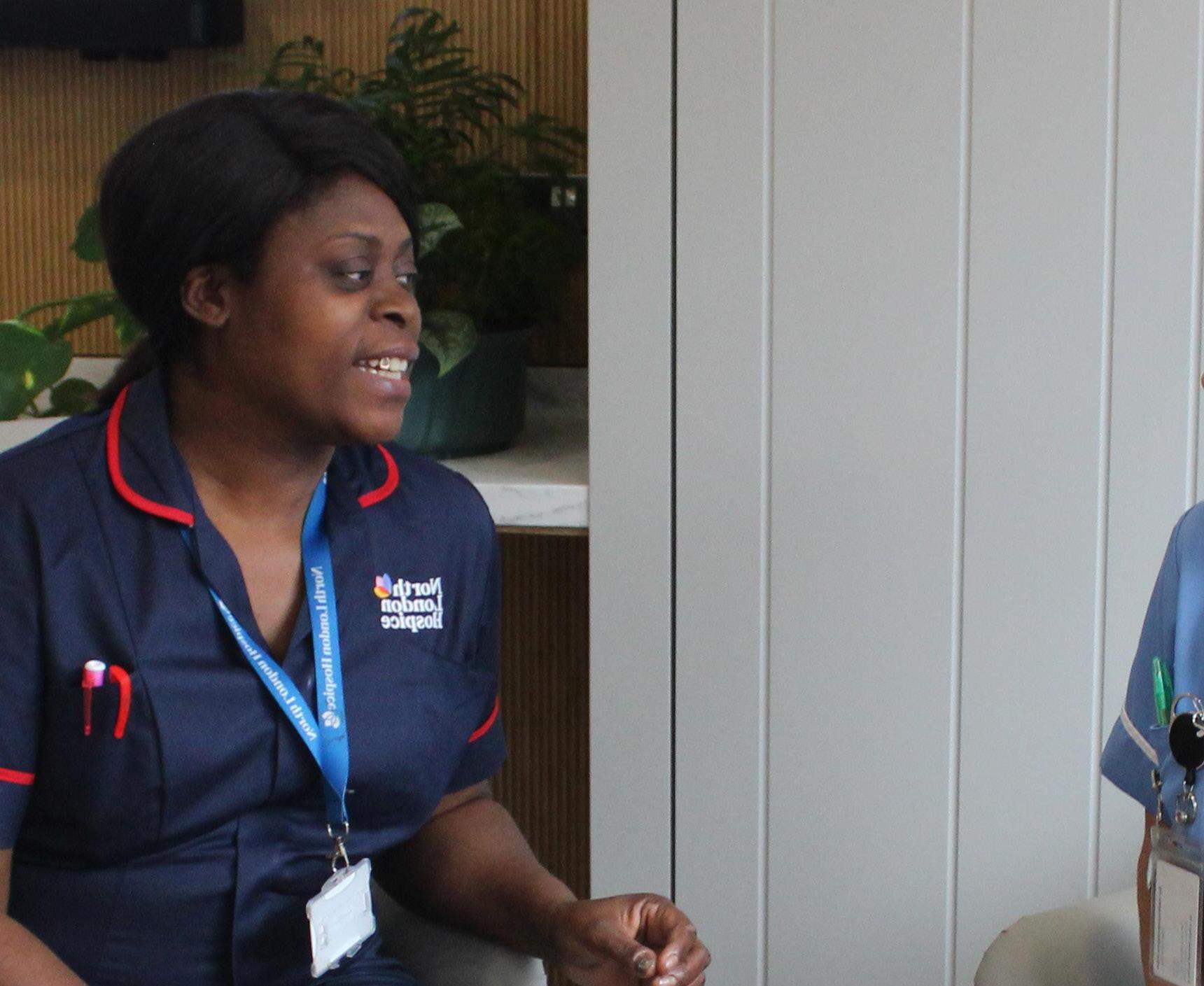
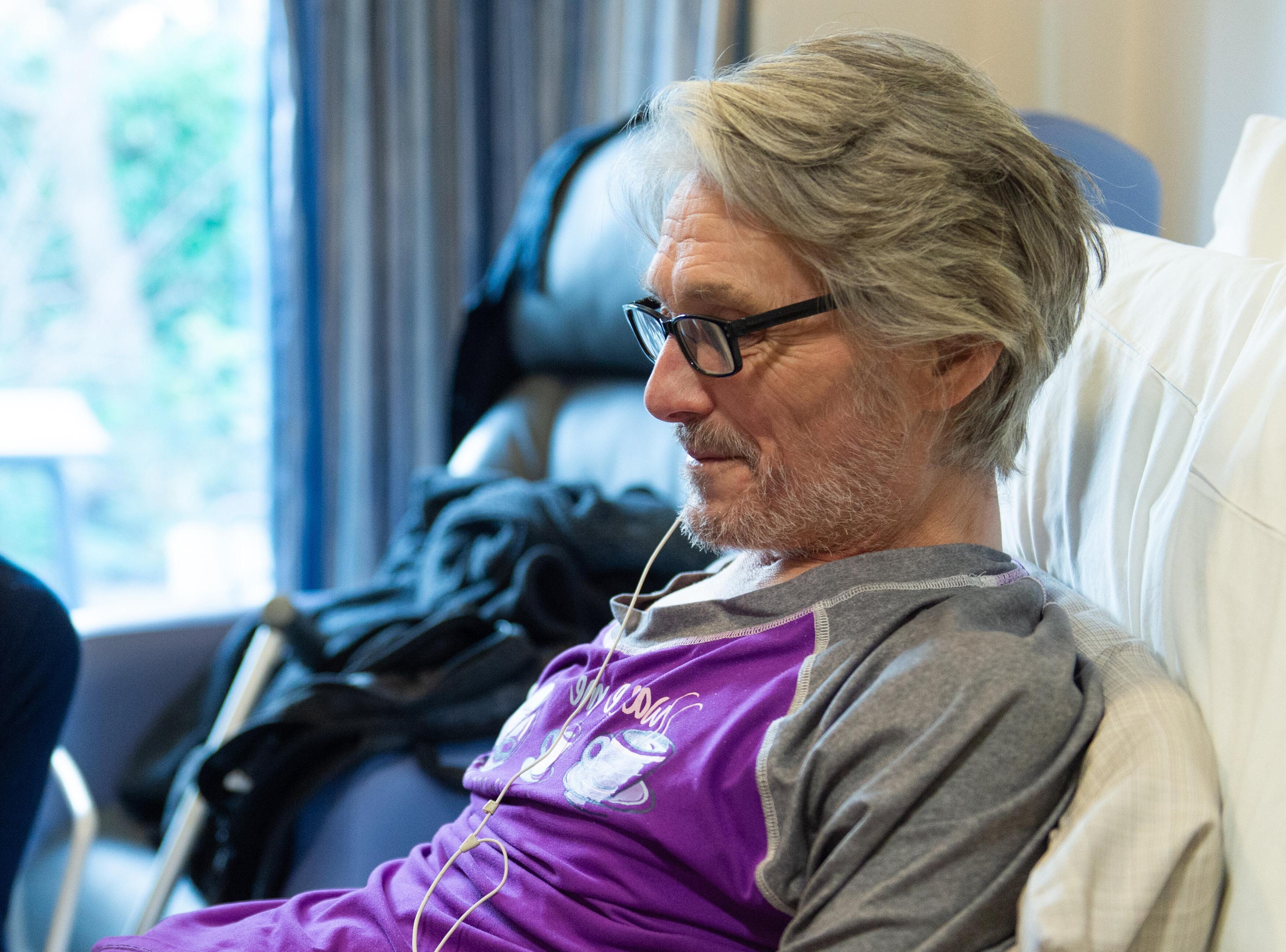
“I
received outstanding care and felt so supported and reassured.”
“As soon as I arrived to smiles and friendly faces, I felt safe. Everyone is so professional, and we’re treated with such dignity.”
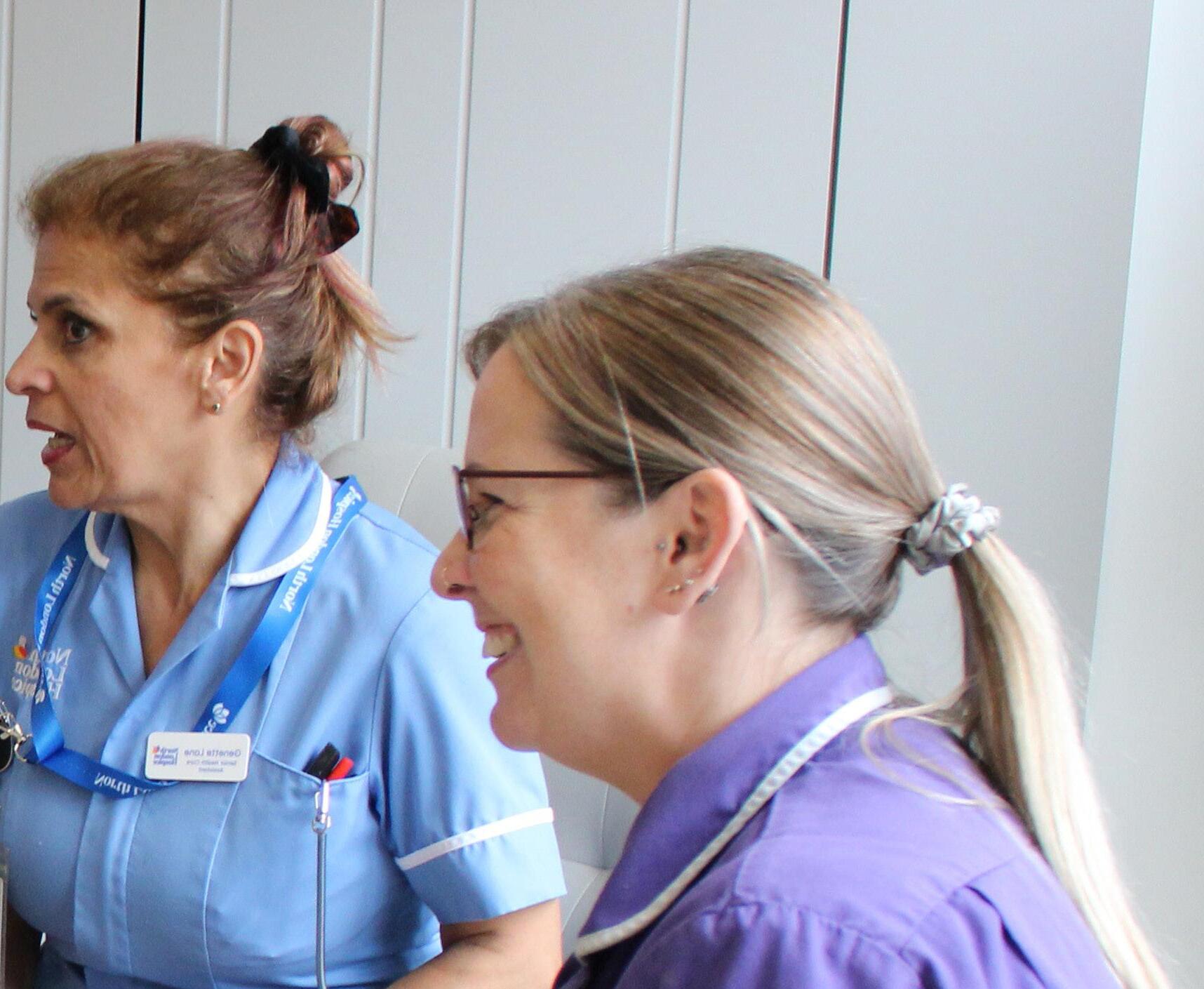
Fundraising
Contents
This year 63 North London companies supported us. In February, 2,087 people joined in our Big Fun Craft fundraiser. 1,993 of these were new to supporting the hospice!
73 people signed up to give us regular gifts. These gifts are vital as they give us some security when we are planning for the future!
62 trusts supported our work last year, funding an array of work from medical equipment for managing patient symptoms to helping patients to access their communities through Compassionate Neighbours.

62 people set up online tribute pages on the Much Loved platform raising money for the hospice in memory of their loved ones. We remain thankful to each of our donors who kindly set up regular gifts for the hospice - these gifts help the hospice with longer-term, sustainable financial planning and we are looking to increase the number of committed supporters the hospice has over the next few years.

Support from Charitable Trusts
We have listed Trusts who have donated over £5,000 to the hospice during the year. We would like to thank them for their recognition of our work and their generous donations. During the next financial year, we look forward to further strengthening our relationships with our highly valued current supporters.
The Albert Hunt Trust
Anonymous Foundations (x3)
The Charles Wolfson Charitable Trust
City Bridge Trust
H&M Charitable Trust
The Hobson Charity Limited
Jesus Hospital in Chipping Barnet
Masonic Charitable Foundation - Hospice UK
Milton Damerel Trust
Pei Ying Chinese School
The Thompson Family Charitable Trust
The Whittington Charitable Trust
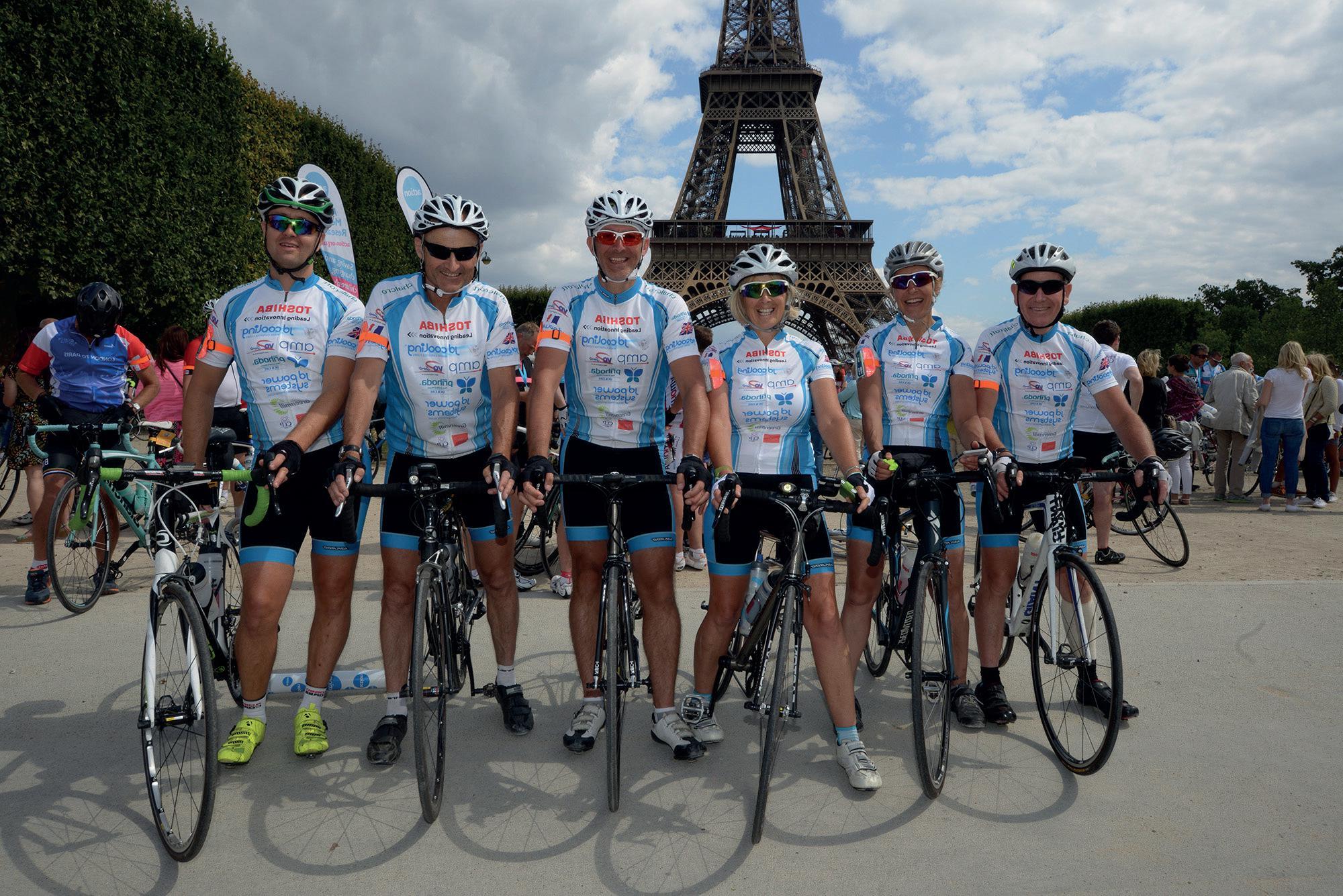



Trustees’ Annual Report for the year ending 31 March 2024
How we are governed
North London Hospice is a company limited by guarantee –registered number 1654807 and a registered charity in England and Wales (charity number 285300). Our constitution is our Articles of Association, which were first adopted on 29th July 1982 and amended on 13th January 2022. The hospice has a wholly owned subsidiary ‘North London Hospice’ (Trading) Limited (charity number 2268094) – the subsidiary company did not trade in the year ending 31st March 2024.
Objectives and principal activities:
The hospice’s objectives are:
• To relieve sickness and suffering and, in particular but without prejudice to the generality of the foregoing, by the establishment and maintenance of a hospice in North London for persons suffering from chronic or terminal diseases.
• To relieve the suffering of the families and friends and in particular, but without prejudice to the generality of the foregoing, by the provision of practical, bereavement and other emotional support and programmes for education and advice.
Structure, Governance and Management
Our Trustees
Our charity is governed by the Board of Trustees who are legally responsible for directing our affairs. The Board determines our long-term strategy and approves our annual strategic priorities and budget. Specific responsibilities are delegated to a number of committees which report back to the Board on a regular basis. The Board delegates day to day management of the charity to the Chief Executive and the Executive Team.
During the year under review, three colleagues left or retired from office - Carol Holmes and Jennifer Walters retired in June 2023 and Dr Mohini Parmar left in October 2023. All three members offered invaluable expertise to the Board and Executive Team and will be sadly missed and we would like to offer our thanks for their commitment and support.
Following a process of recruitment in 2023 we were delighted to welcome two new Trustees –Samantha Durling and Rob Tobin who joined the Board in October 2023. We are looking forward to working with them and value the skills and experience they bring to our already diverse Board. In May 2024 our Chair, Lis Burgess Jones retired after 14 years with North London Hospice as Trustee, Vice Chair and then Chair of the Board of Trustees. We would like to take this opportunity to thank Lis for her hard work and commitment during her time with us. In May 2024 another Trustee, Judith Tobin also retired. Their support and expertise have been integral in providing the services to those we have cared for over the years. All Trustees complete an annual appraisal process with the Chair and Vice Chair together with completion of our Fit & Proper Persons declaration and approved Code of Conduct.
Governance
The Committee framework has been integrated positively into our governance structures and a review in 2023/24 has given us an action plan for improvement. All Trustees are required to disclose potential or actual conflicts of interest to the charity as part of an annual review and at the start of each meeting. The Board continues to adopt the principles of good governance in the Charity Governance Code.
These principles underpin the Board’s governance and form an integral part of the programme of change we have undertaken. The Trustees have taken account of the Charity Commission’s general guidance on public benefit when reviewing our aims, objectives and planning.
Board Committees
Board Development and Remuneration Committee
• Responsible for Board governance arrangements and succession planning and recommendations for the appointment and reappointment of governance and executive positions. Oversight of the performance of and recommendations on the remuneration of the Chief Executive and Executive Team.
Finance & External Audit Committee
• Responsible for the strategic oversight and effective use of the charity’s financial resources and investments. To oversee associated policy, strategy and performance across all finance and investment areas.
Clinical Governance & Assurance Committee
Contents
• Responsible for strategic oversight of the charity’s clinical and patient services to ensure they are safe, effective, caring, responsive and well-led. Provide assurance to the Board on all aspects of the quality of clinical care, clinical risk management, clinical governance systems, compliance with clinical regulatory requirements and standards of quality and safety. To oversee associated policy, strategy and performance in all clinical areas.
Fundraising Committee
• Responsible for strategic oversight of the fundraising delivery and services. To oversee associated policy, strategy and performance across all fundraising income areas.
People and Organisational Development Committee
• Responsible for oversight and delivery assurance of the People, Equality, Diversity & Inclusion strategy and volunteering. To oversee associated policy, strategy and performance across all people (staff and volunteer) areas.
Retail Committee
• Responsible for development and delivery of the retail strategy, exploring shop growth with return on investment and overseeing associated policy, strategy and performance across the retail areas.
Please see page 76 for a full list of Trustees, which also shows movements through the year under review.

Statement of Trustees’ Responsibilities and Corporate Governance
The Trustees are responsible for their annual report, and for the preparation of accounts for each financial year which give a true and fair view of the incoming resources and application of those resources during the year, and of the state of affairs as at the end of the financial year. In preparing these accounts, the trustees are required to:
• ensure that suitable accounting policies are established and applied consistently;
• make judgements and estimates which are reasonable and prudent;
• state whether applicable accounting standards and statement of recommended accounting practice have been followed, subject to any material departures disclosed and explained in the accounts;
• prepare the accounts on a going concern basis unless it is inappropriate to presume that the hospice will continue in operation.
The Trustees confirm that they have complied with the above requirements in preparing the accounts.
The Trustees have overall responsibility for ensuring that the hospice has appropriate systems and controls, financial and otherwise. They are also responsible for keeping proper accounting records which disclose with reasonable accuracy at any time the financial position of the hospice and enable them to ensure that the accounts comply with the Companies Act 2006. They are also responsible for safeguarding the assets of the hospice and for their proper application as required by charity law, and hence for taking reasonable steps for the prevention and detection of fraud and other irregularities and to provide reasonable assurance that:
• the hospice is operating efficiently and effectively;
• all assets are safeguarded against unauthorised use or disposition and are properly applied;
• proper records are maintained and financial information used within the hospice, or for publication, is reliable;
• the hospice complies with relevant laws and regulations.
Reserves Policy
The policy is to always maintain unrestricted reserves at a minimum of nine months of unrestricted operating expenditure, taking account of future forecasts. The Trustees recognise that the current level of reserves is above the minimum requirements as per the policy. The increase in reserves in 2023/2024 was principally due to both higher than expected investment gains and the writing off of accumulated loan interest. This does, however, give Trustees the assurance that the Charity is able to cover the deficits forecast in the 2024/2026 planning cycle.
Moving forward, the Charity has designated some of these reserves for future projects, including a potential IPU refurbishment and investment in the retail shops, as well as creating a legacy buffer should income in this area fall below the long term average.
Accordingly, the existing policy is at a level that the Trustees consider will be adequate.
Current levels of expenditure and maintaining our unrestricted general fund will ensure longterm financial stability and enable the hospice to withstand external events which may affect the level of income received. Planned investments from reserves as part of our current and future strategic priorities in 2023-25 will result in the reduction of the current level of unrestricted general fund.
Investment Policy
The Memorandum and Articles of Association do not place any restrictions on the investment policy to be adopted. The Trustees have invested surplus funds, whilst ensuring easy access to meet the operating costs of the hospice.
Specific investment powers are delegated to Newton Investment Management Limited under the following restrictions:
• No investment in tobacco stocks, unquoted shares, derivatives, or unregulated collective investment schemes;
• Investments are consolidated in Newton Fund for Charities, effectively holding units in a highly diversified but readily accessible portfolio.
During 2024 the charity will be reviewing its investment portfolio and investment policies, ensuring alignment to goals, understanding tolerance to risk and a focus on ongoing sustainability.
Principal Risks and Uncertainties
The Board of Trustees has overall responsibility for risk management of North London Hospice. This includes setting the risk appetite for the charity, ensuring there are reasonable procedures in place for the prevention and detection of major risks, including fraud risk and other irregularities, and ensuring that risk procedures are reviewed when issues arise.
• North London Hospice committee groups meet quarterly to oversee key risk areas, including information governance and data privacy, fraud, and bribery, safeguarding and business continuity. Risks are escalated as appropriate.
• The Executive Team, chaired by the Chief Executive, regularly reviews and monitors key charity-wide strategic and operational risks at its fortnightly meetings
• The Clinical Governance and Assurance Committee scrutinises the management of clinical risks, and the monitoring of clinical incidents and trends.
• Each committee reviews the results of the executive risk management plan and the operation of our risk management processes. Each committee reviews and deep dives into selected key risks as necessary.
In addition, we have policies and procedures to identify and manage risks arising from our existing operations and strategic development, and to provide reasonable assurance against material errors or loss.
Planning and Performance
We operate a comprehensive annual planning and budgeting process. We monitor performance through use of key financial and performance indicators which compare actual results and activity against our plans and are routinely reported to the Board of Trustees. A phased budget and regular forecasting enable the Trustees and the Executive Team to link financial performance with resource and activity levels.
The Finance & External Audit Committee has delegated oversight into this area.
Internal Audit
Internal controls are subject to scrutiny by each committee – we carry out a programme of cyclical reviews throughout North London Hospice. The Executive Team approves and presents the annual audit plan, scrutinises regular reports and present to each committee on progress against the audit plan, the effectiveness of controls in audited functions, and recommendations and learnings from audits.
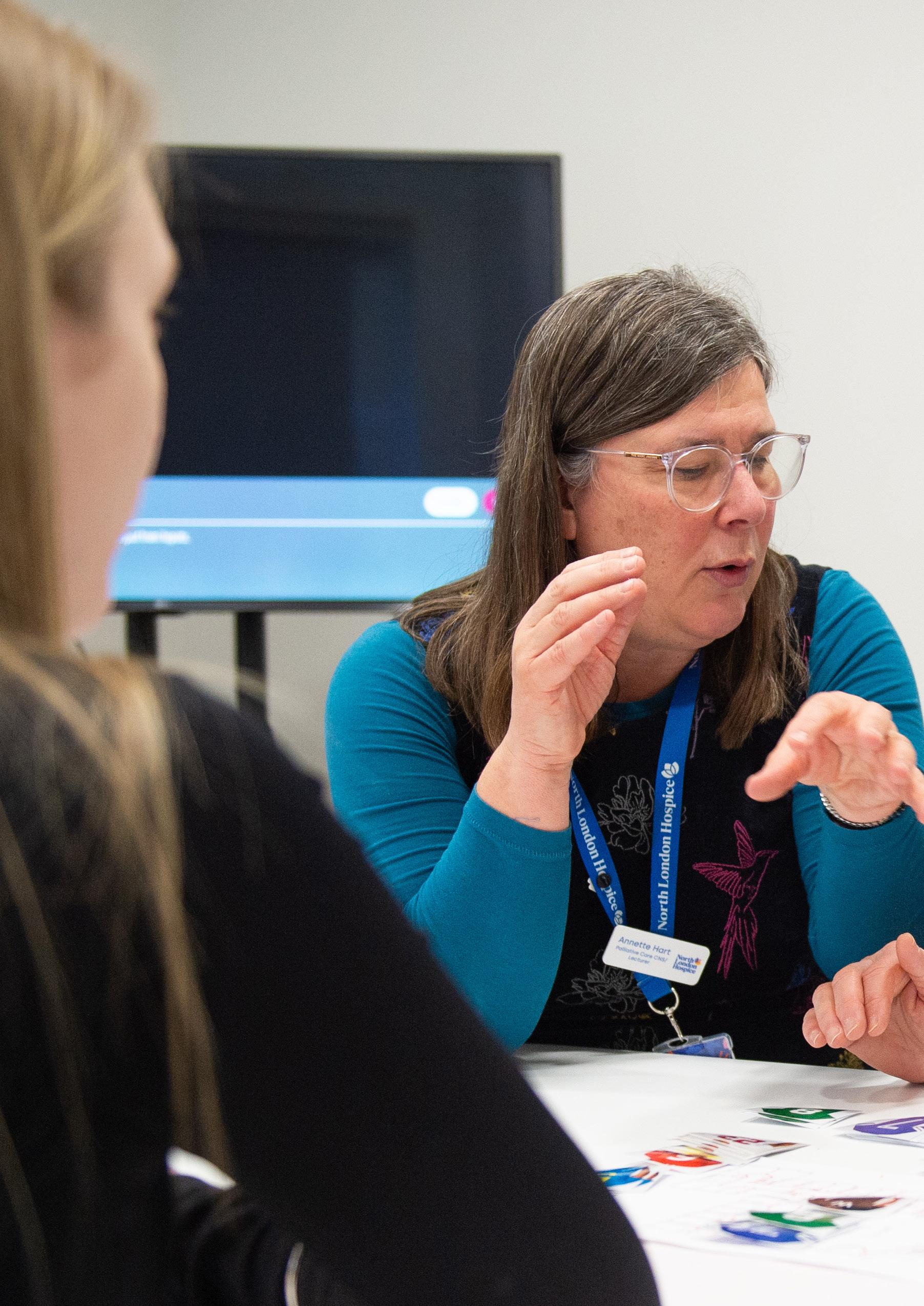
Key Strategic Risk
Contents
An overview of our key strategic risks for 2023/24 and the actions we have taken to mitigate them is summarised in the table below. Each risk area is supported by relevant policies and procedures that are regularly reviewed and updated, and subject to compliance testing.
Risk
FINANCIAL SUSTAINABILITY
Risk that the charity has insufficient funds to deliver plans to sustain services
How we manage it
• Regular monitoring of income and expenditure and regular financial planning and review
• Internal financial controls and policies
• Diversification of income streams and maintenance of prudent financial reserves
• Expert management of investments
• Charity wide assurance groups
SERVICE QUALITY
Risk of quality failure that may result in patient or user harm
STRATEGY AND CHANGE
Risk that the charity is unable to adapt to the changing environment it works in, without clear strategic and operating plans, which may well lead to reduced ability to deliver the highest impact
PEOPLE, CULTURE, WELLNESS
Risk that the charity is unable to recruit, retain and support suitable staff or sustain a culture that supports the delivery of its strategy
• Robust clinical governance processes and oversight
• High quality specialist training for staff
• Quality reviews and compliance checks
• Reviewing and action upon patient and carer feedback, incidents and complaints, and trends
• Proactive engagement with the NHS
• Executive Team leading on the development of the new Strategic Plan, Ambitions, and operating plans
• Board of Trustees oversight of strategy and delivery of operational plans
• Executive Team and Board oversight of significant change programmes
• Balanced Scorecard Reporting
• Learning and Development programmes
• Benchmarking of remuneration and benefits
• Comprehensive and innovative recruitment methods
• Staff and volunteer engagement surveys and forum feedback mechanisms
• Equality, Diversity & Inclusion Strategy, action plan and forum
• Freedom to Speak Up Guardians
• Access to Employee Assistance Programme and Occupational Health
Risk
SAFEGUARDING
Risk that inability to safeguard vulnerable adults may lead to serious harm/abuse
GOVERNANCE AND COMPLIANCE
Risk that failures in governance or compliance may lead to poor decision making, or legal or regulatory action
HEALTH AND SAFETY & THE ENVIRONMENT
Risk that failures to act in accordance with guidance could cause harm, negatively impact service delivery and lead to legal or regulatory action
DATA GOVERNANCE, SECURITY, PRIVACY AND QUALITY
Risk that inadequate systems for the governance, privacy and security of data may lead to harm, negatively impact service delivery and lead to legal or regulatory action
INFRASTRUCTURE
Risk that core systems and technology are inadequate to serve strategy and service needs
REPUTATION
Risk that incidents or events may damage or negatively impact our reputation or operations
How we manage it
• Safeguarding leads within the charity
• Safe recruitment practices, including pre-employment checks and screening
• Regular role-specific mandatory safeguarding training
• Promotion of Freedom to Speak up Guardians
• Clinical Governance & Assurance Committee and charity-wide assurance groups to monitor standards, performance, service developments, incidents, and complaints
• Policies, procedures, and guidance supported by training and specialist roles
• Specialist Health and Safety group and engaged consultant
• Project group to examine environmental impact of our activity.
• Green Pledge
• Privacy and security impact assessments for all new business initiatives
• Security audits and reviews
• Mandatory training and guidance for all staff
• Specialist roles – Senior Information Risk Officer, Data Protection Officer, Caldicott Guardian
• Information Governance Group – through business continuity policy
• Internal audit and self-assessment
• External testing and benchmarking
• Continuous improvement programmes
• Review of IT support and new strategy
• Business continuity plan
• Executive Team meetings
• Public liability and professional indemnity insurance
• Communications Team
Complaints and Concerns
In 2023/24 we recorded a total of 30 complaints and 495 compliments. Complaints form a minority of the feedback we receive. The overarching themes in complaints were communication, including alignment to organisational values and behaviours, followed by patient care and availability of equipment for our community-based patients.
Overarching themes in compliments were kindness, compassion and empathy of staff, outstanding communication of clinical staff and excellent holistic care for both patients and carers.
Of the 30 complaints:
• 18 related to clinical patient services
• 8 related to retail
• 3 related to facilities
• 1 related to communications
Financial Review of the Year
The financial year 23/24 saw the Charity enter a period of transformation. A significant deficit of nearly £3m in 22/23 highlighted the need for future sustainability and a plan to achieve a balanced budget, whilst continuing to deliver excellent care. With significant investment planned over the coming years, in both IPU and retail, there remains a need to maintain a strong level of reserves, whilst maintaining and improving beneficiary impact.
At the headline level there was a surplus in 23/24 of £1.6 million (22/23 deficit £3.0 million). Whilst this was a welcome out-turn, it was primarily due to the increase in the value of investments (£1.3 million), a write-back of accumulated loan interest (£1.3 million), together with fundraising receiving an unexpected trust fund donation of over £1 million. Without these items there would have been an underlying deficit of £2 million. The Charity has budgeted a deficit of £0.9 million in 24/25 as it moves towards a balanced budget.
Total incoming resources were £15.3 million in the year ended 31 March 2024, compared with £12.1 million in the year ended 31 March 2023.
Total donations and fundraising were £3.3m, of which £0.1 million is restricted income. Events income performed well in the year, especially Big Fun Walk and the London Marathon, as did Trust income. The landscape continues to be challenging in all areas and we will continue to find new ways of working and new offerings.
Legacy income of £2.3 million in 23/24 was £1.1 million higher than the previous year. Prior year legacy income was significantly lower than expected, with 23/24 returning closer to the long term expected average.
Total grants income was £5.4 million compared with £5.2 million in the previous year of which £0.8 million (2023: £1.3 million) was restricted.
Other trading activities reflect the charity shops operations, made up of charity shops sales of £2.8 million (2023: £3.0 million), donations of agency sales and Gift Aid of £1 million (2023: £0.5 million) and rental income of £14K (2023: £12K).
Investment income of £395K was £77K higher than the previous year, which coupled with the increase in the value of the fund, resulted in a 10% total return on investments.
Total expenditure was £15.0 million, compared with £14.5 million in the previous year. Inflationary pressures continued to have a significant impact on expenditure and the Charity will continue to ensure money is invested wisely with the key aim of putting patients at the heart of everything we do.
Position of the Charity at the End of the Year
The unrestricted general fund at the year-end (excluding designations) represented some 13 months of underlying unrestricted expenditure and is above the reserves policy of holding at least 9 months of unrestricted expenditure.
Principal Risks and Uncertainties
As referred to in the message from the Chair and Chief Executive, there are continuing challenges facing all hospices, to which North London Hospice is not unique. Whether that is uncertainty regarding the levels of future NHS funding, inflationary pressures or increasing fundraising targets, all of these have a part to play in ensuring North London Hospice continues to deliver the wide range of services that are currently supported. The hospice will continue to look to invest reserves in areas which result in quality improvements in patient care.
Public Benefit Statement
Contents
The Trustees confirm that they have complied with the duty in section 17 of the Charities Act 2011 to have due regard to the Charity Commission’s general guidance on public benefit, “Charities and Public Benefit”.
North London Hospice’s objects comply directly with two of the Charities Act’s descriptions of “charitable purpose”:
• “the advancement of health” and
• “the relief of those in need, by reason of youth, age, ill-health, disability, financial hardship or other disadvantage”
The hospice’s charitable purpose is enshrined in the wording of the hospice’s objects.
The Trustees ensure that this purpose is carried out for the public benefit by delivering services that are valued by our patients, their families and friends and the community in general.
Hospice services are available to those most in need of the services in the London boroughs of Barnet, Enfield, and Haringey. The hospice provides specialist palliative care in an inpatient, outpatient and therapies and community setting.
Disclosure of Information to the Auditor
As far as the Trustees are aware, there is no relevant information of which the company’s auditor is unaware. The Trustees have taken all the steps that they ought to have taken as Trustees to make themselves aware of any relevant audit information and to establish that the company’s auditor is aware of that information.
Approved by the Board of Trustees on 10 July 2024 and signed on its behalf by:
SIMON MORRIS MBE Chair of Trustees
ANDREW J. HARRIS Company Secretary and Honorary Treasurer
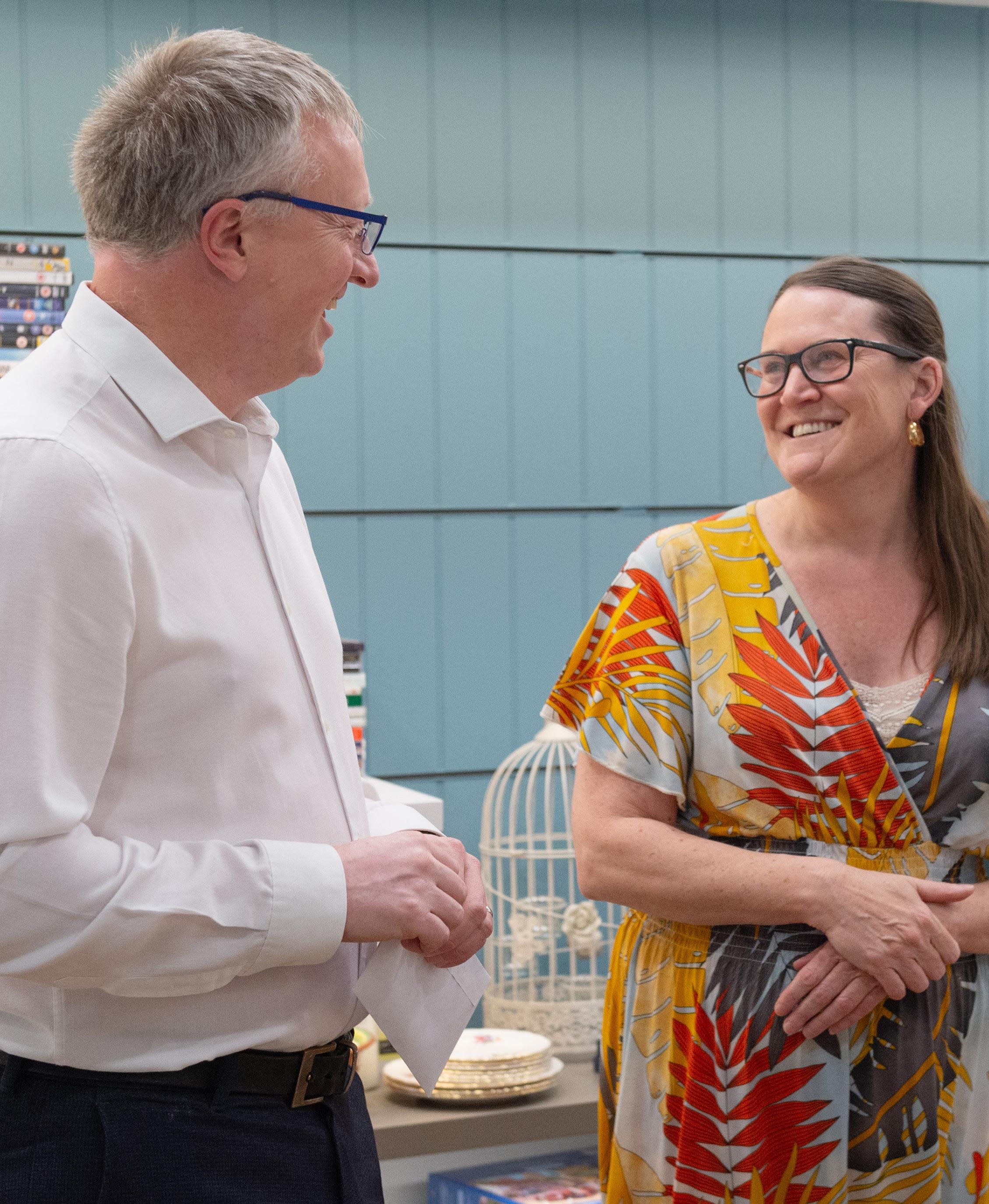
Independent Auditors Report to the Members of North London Hospice
Opinion
We have audited the accounts of North London Hospice (the 'charitable company') for the year ended 31st March 2024 which comprise the statement of financial activities, the balance sheet, the statement of cash flows, the principal accounting policies and the notes to the accounts. The financial reporting framework that has been applied in their preparation is applicable law and United Kingdom Accounting Standards, including “The Financial Reporting Standard Applicable in the UK and Republic of Ireland”(United Kingdom Generally Accepted Accounting Practice).
In our opinion the accounts:
• give a true and fair view of the state of the charitable company's affairs as at 31st March 2024, and of its expenditure for the year then ended;
• have been properly prepared in accordance with United Kingdom Generally Accepted Accounting Practice;
• have been prepared in accordance with the requirements of the Companies Act 2006.
Basis for opinion
We conducted our audit in accordance with International Standards on Auditing (UK) and applicable law. Our responsibilities under those standards are further described in the auditor’s responsibilities for the audit of accounts section of our report. We are independent of the charitable company in accordance with the ethical requirements that are relevant to our audit of the accounts in the UK, including the FRC’s Ethical Standard, and we have fulfilled our other ethical responsibilities in accordance with these requirements. We believe that the audit evidence we have obtained is sufficient and appropriate to provide a basis for our opinion.
Conclusions relating to going concern
In auditing the accounts, we have concluded that the Trustees’ use of the going concern basis of accounting in the preparation of the accounts is appropriate.
Based on the work we have performed, we have not identified any material uncertainties relating to events or conditions that, individually or collectively, may cast significant doubt on the charitable company’s ability to continue as a going concern for a period of at least twelve months from when the accounts are authorised for issue.
Our responsibilities and the responsibilities of the Trustees with respect to going concern are described in the relevant sections of this report.
Other information
The other information comprises the information included in the Trustees’ annual report, including the strategic report and the impact report, other than the accounts and our auditor’s report thereon.
The trustees are responsible for the other information contained within the annual report. Our opinion on the accounts does not cover the other information and, except to the extent otherwise explicitly stated in our report, we do not express any form of assurance conclusion thereon.
Our responsibility is to read the other information and, in doing so, consider whether the other information is materially inconsistent with the accounts or our knowledge obtained in the audit or otherwise appears to be materially misstated. If we identify such material inconsistencies or apparent material misstatements, we are required to determine whether there is a material misstatement in the accounts themselves. If, based on the work we have performed, we conclude that there is a material misstatement of this other information, we are required to report that fact.
We have nothing to report in this regard.
Opinions on other matters prescribed by the Companies Act 2006
In our opinion, based on the work undertaken in the course of the audit:
• the information given in the Trustees’ annual report which is also the directors’ report for the purposes of company law, and includes the strategic report and the impact report for the financial year for which the accounts are prepared is consistent with the accounts; and
• the Trustees’ report, which is also the directors’ report for the purposes of company law, and includes the strategic report and the impact report have been prepared in accordance with applicable legal requirements.
Matters on which we are required to report by exception
In the light of the knowledge and understanding of the charitable company and its environment obtained in the course of the audit, we have not identified material misstatements in the Trustees’ annual report including the strategic report and the impact report. We have nothing to report in respect of the following matters in relation to which the Companies Act 2006 requires us to report to you if, in our opinion:
• adequate accounting records have not been kept by the charitable company, or returns adequate for our audit have not been received from branches not visited by us; or
• the charitable company’s accounts are not in agreement with the accounting records and returns; or
• certain disclosures of trustees’ remuneration specified by law are not made; or
• we have not received all the information and explanations we require for our audit.
Responsibilities of Trustees
As explained more fully in the Trustees’ responsibilities statement set out on page 41, the Trustees (who are also the directors of the charitable company for the purposes of company law) are responsible for the preparation of the accounts and for being satisfied that they give a true and fair view, and for such internal control as the Trustees determine is necessary to enable the preparation of accounts that are free from material misstatement, whether due to fraud or error.
In preparing the accounts, the Trustees are responsible for assessing the charitable company’s ability to continue as a going concern, disclosing, as applicable, matters related to going concern and using the going concern basis of accounting unless the Trustees either intend to liquidate the charitable company or to cease operations, or have no realistic alternative but to do so.
Auditor’s responsibilities for the audit of the accounts
Our objectives are to obtain reasonable assurance about whether the accounts, as a whole, are free from material misstatement, whether due to fraud or error, and to issue an auditor’s report that includes our opinion. Reasonable assurance is a high level of assurance but is not a guarantee that an audit conducted in accordance with ISAs (UK) will always detect a material misstatement when it exists. Misstatements can arise from fraud or error and are considered material if, individually or in the aggregate, they could reasonably be expected to influence the economic decisions of users, taken on the basis of these accounts.
Irregularities, including fraud, are instances of non-compliance with laws and regulations. We design procedures in line with our responsibilities, outlined above, to detect material misstatements in respect of irregularities, including fraud. The extent to which our procedures are capable of detecting irregularities, including fraud is detailed below:
How the audit was considered capable of detecting irregularities including fraud
Our approach to identifying and assessing the risks of material misstatement in respect of irregularities, including fraud and non-compliance with laws and regulations, was as follows:
• The engagement partner ensured that the engagement team collectively had the appropriate competence, capabilities and skills to identify or recognise non-compliance with applicable laws and regulations;
• We identified the laws and regulations applicable to the charity through discussions with management and trustees and from our knowledge and experience of the charity sector;
• We focused on specific laws and regulations which we considered may have a direct material effect on the accounts or the activities of the charity. These included but were not limited to the Companies Act 2006; the Charities Act 2011; Accounting and Reporting by Charities: Statement of Recommended Practice applicable to charities preparing their accounts in accordance with the Financial Reporting Standard applicable to the United Kingdom and Republic of Ireland (FRS 102) (effective 1 January 2019), legislation and regulations specific to Hospices (including the Care Quality Commission), Safeguarding Regulations, GDPR, fundraising regulations; and
• We assessed the extent of compliance with laws and regulations identified above by making enquiries of management and representatives of the trustees and review of the minutes of trustees’ meetings.
We assessed the susceptibility of the charity’s accounts to material misstatement, including how fraud might occur by:
• Making enquiries of management and representatives of the trustees as to where they considered there was susceptibility to fraud, their knowledge of actual, suspected and alleged fraud; and
• Considering the internal controls in place to mitigate risks of fraud and non-compliance with laws and regulations.
To address the risk of fraud through management bias and override of controls, we:
• Performed analytical procedures to identify any unusual or unexpected relationships;
• Tested and reviewed journal entries to identify unusual transactions;
• Verified the implementation of financial controls;
• Assessed whether judgements and assumptions made in determining the accounting estimates were indicative of potential bias; and
• Investigated the rationale behind significant or unusual transactions.
In response to the risk of irregularities and non-compliance with laws and regulations, we designed procedures which included, but were not limited to:
• Agreeing accounts disclosures to underlying supporting documentation;
• Reading the minutes of meetings of trustees; and
• Enquiring of as to actual and potential litigation and claims.
There are inherent limitations in our audit procedures described above. The more removed that laws and regulations are from financial transactions, the less likely it is that we would become aware of non-compliance.
Auditing standards also limit the audit procedures required to identify non-compliance with laws and regulations to enquiry of the trustees and other management and the inspection of regulatory and legal correspondence, if any.
Material misstatements that arise due to fraud can be harder to detect than those that arise from error as they may involve deliberate concealment or collusion.
A further description of our responsibilities for the audit of the financial statements is located on the Financial Reporting Council’s website at www.frc.org.uk/auditorsresponsibilities. This description forms part of our auditor’s report.
Use of our report
This report is made solely to the charitable company’s members, as a body, in accordance with Chapter 3 of Part 16 of the Companies Act 2006. Our audit work has been undertaken so that we might state to the charitable company’s members those matters we are required to state to them in an auditor’s report and for no other purpose. To the fullest extent permitted by law, we do not accept or assume responsibility to anyone other than the charitable company and the charitable company’s members as a body, for our audit work, for this report, or for the opinions we have formed.
25 July 2024
EDWARD FINCH (Senior Statutory Auditor) for and on behalf of Buzzacott LLP, Statutory Auditor 130 Wood Street London EC2V 6DL
ContentsStatement of Financial Activities
NORTH LONDON HOSPICE
NORTH LONDON HOSPICE STATEMENT OF FINANCIAL ACTIVITIES, INCLUDING THE INCOME AND EXPENDITURE ACCOUNT
STATEMENT OF FINANCIAL ACTIVITIES, INCLUDING THE INCOME AND EXPENDITURE ACCOUNT
Reconciliation of funds:
Total
All incoming
and resources expended derive from continuing activities.
All incoming resources and resources expended derive from continuing activities.
The statement of financial activities includes all gains and losses recognised in the year.
The statement of financial activities includes all gains and losses recognised in the year.
The detailed comparative information for the statement of financial activities is included at note 23.
The detailed comparative information for the statement of financial activities is included at note 23.
The attached notes form part of these accounts.
The attached notes form part of these accounts. 31ST MARCH 2024
Approved for issue by the Board of Trustees on 10th July 2024 and signed on its behalf by:31ST MARCH
The attached notes form part of these accounts. Approved for issue by the Board of Trustees on 10th July 2024 and signed on its behalf by:-
SIMON MORRIS Chair
SIMON B. MORRIS (Chair) ANDREW J. HARRIS (Treasurer)
SIMON B. MORRIS (Chair) ANDREW J. HARRIS (Treasurer)
The attached notes form part of these accounts.
ANDREW J. HARRIS Treasurer
STATEMENTS OF CASH FLOWS
Reconciliation of
Reconciliation of net movement in funds to net cash flow from operating activities
Reconciliation of net movement in funds to net cash flow from operating activities
movement in funds 1,613,677 (2,972,003)
(351,977) (293,023)
(43,274) (25,926)
2,487,110 3,259,435
in
3,206 3,109 Total £ 2,490,316 3,262,544
Analysis of changes in net funds
Company information
Contents
North London Hospice is a company limited by guarantee incorporated in England and Wales. The registered office is 47 Woodside Avenue, London, N12 8TF.
a) Basis of preparation of accounts and assessment of going concern
The accounts have been prepared under the historical cost convention with the exception of investments which are included at their market value. The accounts have been prepared in accordance with the Statement of Recommended Practice: Accounting and Reporting by Charities preparing their accounts in accordance with the Financial Reporting Standard applicable in the UK and Republic of Ireland (FRS 102) issued in October 2019, the Companies Act 2006 and Charities Act 2011.
The accounts are prepared in sterling, which is the functional currency of the company.
Assets and liabilities are initially recognised at historical cost or transaction value unless otherwise stated in the relevant accounting policy notes.
The trustees have prepared the accounts on the going concern basis which assumes the charitable company will continue in operational existence for the foreseeable future as the trustees consider that there are no material uncertainties about the charity’s ability to continue as a going concern. The level of reserves held mean that the trustees expect the charity to be able to continue its activities for a period of at least 12 months from the approval of these accounts.
North London Hospice meets the definition of a public benefit entity under FRS 102.
b) Fund accounting
General funds are unrestricted funds which are available for use at the discretion of the trustees in furtherance of the general objectives of the charity and which have not been designated for other purposes.
Designated funds comprise unrestricted funds that have been set aside by the trustees for particular purposes. The aim and use of each designated fund is set out in the notes to the accounts.
Restricted funds are funds which are to be used in accordance with specific restrictions imposed by donors or which have been raised by the charity for particular purposes. The costs of raising and administering such funds are charged against the specific fund. The aim and use of each restricted fund is set out in the notes to the accounts.
Endowment funds are capital funds that must be retained for the benefit of the charity. The use of income arising from these capital sums may be subject to restrictions.
Investment income, gains and losses are allocated to the appropriate fund.
c)
Income
All income is recognised once the charity has entitlement to the income, it is probable that the income will be received and the amount of income receivable can be measured reliably.
For legacies, entitlement is taken as the earlier of the date on which either: the charity is aware that probate has been granted, the estate has been finalised and notification has been made by the executor to the Trust that a distribution will be made, or when a distribution is received from the estate. Receipt of a legacy, in whole or in part, is only considered probable when the amount can be measured reliably and the charity has been notified of the executor’s intention to make a distribution. Where legacies have been notified to the charity, or the charity is aware of the granting of probate, and the criteria for income recognition have not been met, then the legacy is treated as a contingent asset and disclosed if material.
Donations are accounted for when received by the charity. Donated agency sales relating to proceeds from sale of goods subsequently donated to the charity are accounted for when confirmed by the donor. Tax reclaimed in respect of Gift Aid is accounted for on an accruals basis. Tangible assets donated are included in the accounts at their market value. Goods donated to fundraising shops are included in the accounts when sold. The charity also receives the benefit of work carried out by volunteers, the value of which cannot be quantified.
c) Income (continued)
Grant and service level agreement income is recognised in the period to which the income relates. Income from investments has been taken into the accounts when receivable. Interest receivable has been accounted for on an accruals basis.
d) Expenditure and irrecoverable value added tax
Expenditure is recognised once there is a legal or constructive obligation to make payment to a third party, it is probable that settlement will be required and the amount of the obligation can be measured reliably. All expenditure is accounted for on an accruals basis. Staff and other costs are allocated directly to the activity for which they are incurred. Costs of raising funds comprises the costs associated with attracting voluntary income and the costs of operating the charity’s shops.
Charitable activities expenditure comprises those costs incurred in the delivery of hospice services. It includes both costs that can be directly allocated and those of an indirect nature necessary to support them including governance costs.
Not all value added tax is recoverable. Irrecoverable VAT is charged against the expenditure heading for which it was incurred.
e) Capitalisation and depreciation
The trustees have adopted the policy that small items of expenditure, being those less than £1,000, of a capital nature are not capitalised but are included in resources expended.
Freehold land is not depreciated. Tangible fixed assets are stated at cost less depreciation. Depreciation is provided at rates calculated to write off the cost of fixed assets, less their estimated residual value, over their expected useful lives on the following bases:
Freehold buildings - 2% straight-line
Furniture, fixtures, fittings
and medical equipment - 20% straight-line
Motor vehicles - 25% straight-line
Refurbishment - 10% straight-line
f) Investments
Investments are a form of basic financial instrument and are initially recognised at their transaction value and subsequently measured at their fair value as at the balance sheet date using the closing quoted market price. The statement of financial activities includes the net gains and losses arising on revaluation and disposals throughout the year.
The charity does not acquire put options, derivatives or other complex financial instruments.
The main form of financial risk faced by the charity is that of volatility in equity markets and investment markets due to wider economic conditions, the attitude of investors to investment risk, and changes in sentiment concerning equities and within particular sectors or sub sectors.
g) Stocks
Contents
Stocks of donated goods to fundraising shops are not reflected in the accounts because the trustees consider it is impracticable to be able to assess the value of donated goods until sale as there are no systems in place which record these items until they are sold and undertaking a stock take would incur undue cost for the charity which far outweighs the benefits.
h) Debtors
Trade and other debtors are recognised at the settlement amount after any trade discount offered. Prepayments are valued at the amount prepaid.
i) Cash at bank and in hand
Cash at bank and in hand includes cash and short term highly liquid investments with a short maturity of three months or less from the date of acquisition or opening of the deposit or similar account.
j) Creditors and provisions
Creditors and provisions are recognised where the charity has a present obligation resulting from a past event that will probably result in the transfer of funds to a third party and the amount due to settle the obligation can be measured or estimated reliably. Creditors and provisions are normally recognised at their settlement amount after allowing for any trade discounts due.
k) Financial instruments
The charity only has financial assets and financial liabilities of a kind that qualify as basic financial instruments. Basic financial instruments are initially recognised at transaction value and subsequently measured at their settlement value.
l) Pensions
The charity contributes to defined benefit and defined contribution schemes on behalf of its employees.
The assets of the defined benefit scheme are held separately from those of the Hospice by the National Health Service Superannuation Scheme.
The assets of the National Health Service Superannuation Scheme cannot be identified on a consistent and reasonable basis. Contributions to the scheme are charged to the statement of financial activities so as to spread the cost of pensions over employees’ working lives with the charity. The contributions are determined by qualified actuaries on the basis of periodic valuations.
Defined contribution scheme pension costs charged in the accounts represent the amounts payable to the scheme in respect of the year. Where employees’ wages and salaries are allocated to unrestricted or restricted funds, the pension costs relating to those employees, and any associated liabilities, are allocated to the same funds.
m) Operating leases
Rental costs under operating leases are charged in the accounts in equal annual instalments over the period of the leases.
1. Legal status
North London Hospice is a company limited by guarantee and has no share capital. It is registered in England and Wales. The members of the company are the trustees named on page 57, of which there were 14 at 31st March 2024 (2023 - 15). In the event of the company being wound up, the liability in respect of the guarantee is limited to £1 per member of the company.
2. Judgements in applying accounting policies and key sources of estimation uncertainty
In the application of the charity’s accounting policies, the trustees are required to make judgements, estimates and assumptions about the carrying amount of assets and liabilities that are not readily apparent from other sources. The estimates and associated assumptions are based on historical experience and other factors that are considered to be relevant. Actual results may differ from these estimates.
The estimates and underlying assumptions are reviewed on an ongoing basis. Revisions to accounting estimates are recognised in the period in which the estimate is revised, if the revision affects only that period, or in the period of the revision and future periods if the revision affects both current and future periods.
Key sources of estimation uncertainty
The annual depreciation charge for tangible fixed assets is sensitive to changes in the estimated useful economic lives and residual values of the assets. The useful economic lives and residual values are re-assessed annually. They are amended when necessary to reflect current estimates, based on technological advancement, future investments, economic utilisation and the physical condition of the assets. See note 12 for the carrying amount of the tangible fixed assets and accounting policy e) for the useful economic lives for each class of asset.
3. Group accounts
The charity has one wholly owned subsidiary company, North London Hospice (Trading) Limited. Group accounts have not been prepared as the subsidiary company is dormant and not material in the context of the group. Accordingly, these accounts present information about the charity as an individual entity and not about its group
Year ended 31st March 2024 North Central London -
Year ended 31st March 2023 North Central London -
5,210,222
5. Investment income
Investment income Year ended 31st March 2024
Year ended 31st March 2023
ended 31st March 2023
Year ended 31st March 2023 (restated, see Note 11)
Year ended 31st March 2023 (restated, see Note 11)
Year ended 31st March 2024
Year ended 31st March 2023 (restated, see Note 11) Direct
Note 10)
Support costs including governance costs incurred relating to fundraising and promotion and charity shops are immaterial. Consequently all support costs are included in the cost of operation of hospice.
Year ended 31st March 2024
Year ended 31st March 2024
Governance costs
10. Governance costs
Year ended 31st March 2024
Year ended 31st March 2024
Year ended 31st March 2024
Year ended 31st March 2023
Year ended 31st March 2023
Year ended 31st March 2023
Year ended 31st March 2023
Auditors' remuneration
Year ended 31st March 2023
Auditors' remuneration
11. Staff costs, trustee remuneration and expenses and the cost of key management personnel
11. Staff costs, trustee remuneration and expenses and the cost of key management personnel
11. Staff costs, trustee remuneration and expenses and the cost of key management personnel
The charity operates both defined benefit and defined contribution schemes for its employees, the pension charge for the year is shown above. At the balance sheet date £79,409 (2023 - £68,756) was accrued for pension costs.
The charity operates both defined benefit and defined contribution schemes for its employees, the pension charge for the year is shown above. At the balance sheet date £79,409 (2023 - £68,756) was accrued for pension costs.
The charity operates both defined benefit and defined contribution schemes for its employees, the pension charge for the year is shown above. At the balance sheet date £79,409 (2023 - £68,756) was accrued for pension costs.
The charity operates both defined benefit and defined contribution schemes for its employees, the pension charge for the year is shown above. At the balance sheet date £79,409 (2023 - £68,756) was accrued for pension costs.
Prior year wages and salaries costs totalling £180,043 have been restated to other costs and other medical cost for
Prior year wages and salaries costs totalling £180,043 have been restated to other costs and other medical cost for fundraising, charity shops and cost of hospice.
charity shops and cost of hospice.
The charity operates both defined benefit and defined contribution schemes for its employees, the pension charge for the year is shown above. At the balance sheet date £79,409 (2023 - £68,756) was accrued for pension costs.
Prior year wages and salaries costs totalling £180,043 have been restated to other costs and other medical cost for
charity shops and cost of hospice.
Prior year wages and salaries costs totalling £180,043 have been restated to other costs and other medical cost for fundraising, charity shops and cost of hospice.
Analysis by function:
Prior year wages and
The number of higher paid employees was:
The number of higher paid employees was:
number of higher paid employees was:
The number of higher paid employees was:
11. Staff costs, trustee remuneration and expenses and the cost of key management personnel
Contributions were made to a defined benefit scheme for thirteen (2023 - eight) higher paid employees and to a defined contribution scheme for nine (2023 - ten) higher paid employees. Total contributions in the year amounted to £125,070 (2023 - £75,738).
No trustees have received any remuneration in respect of their services or had any expenses reimbursed (2023 - the same).
The average number of employees, analysed by function, was:
The average number of employees reflects the average actual number of employees rather than the average full-time equivalents (FTE).
The staff costs and numbers of employees do not include any allowance for the work carried out for the Hospice by over 600 volunteers have carried out a variety of roles including welcoming visitors to the Hospice, assisting staff in the inpatient unit in serving meals, helping to transport patients to and from the Outpatients and Wellbeing Service, carrying out numerous administrative functions and helping at fundraising events, and a significant number of volunteers assist in our charity shops. The value of this work cannot be quantified.
The key management personnel of the charitable company are the trustees and the executive team, comprising the Chief Executive Officer, the Medical Director and Consultant, the Director of Patient Services, the Director of Nursing and Quality, the Director of Fundraising and Communications, the Director of Finance and Resources and the Director of People and Culture. The employee benefits of the key management personnel totalled £676,504 (2023 - £584,967).
12. Tangible fixed assets
Freehold land and buildings includes buildings with a cost of of £8,769,618 (2023 - the same) that are being depreciated.
Freehold land and buildings have not been revalued. The trustees consider that there is no advantage in obtaining a valuation as the land and buildings are used exclusively for charitable purposes.
All assets are held for charitable use.
investments:
at 1st April 2023
The historical cost of the listed investments as at 31st March 2024 was £10,251,649 (2023 - £9,899,671).
Reconciliation of unrealised gains/(losses)
gains at 1st April 2023
(510,821) Unrealised gains at 31st March 2024 6,469,583 5,145,615
At 31st March 2024 the listed investments all related to UK equities listed on the International Stock Exchange, London
At 31st March 2024 UK equities comprised:
7,188,746.047 units in the Newton Sustainable Growth and Income Fund for Charities
2,286,450.814 units in the Newton Growth & Income Fund for Charities
The Hospice owns 100% of the ordinary share capital of North London Hospice (Trading) Limited, a company registered in England and Wales, company number 2268094. The registered office address of North London Hospice (Trading) Limited is 47 Woodside Avenue, London, N12 8TF.
Until 31st March 2018 North London Hospice (Trading) Limited sold goods on behalf of the public for commission, following which the owners were invited to donate the proceeds to the charity under the gift aid scheme. Since 1st April 2018 this has been dealt with directly by the charity as donated agency sales.
14. Debtors
Prepayments and accrued income includes measurable legacies committed to North London Hospice as at 31st March 2024, but which were not received by that date, amounting to £2,742,484 (2023 - £2,008,296).
15. Creditors: amounts falling due within one year
Other creditors includes £324,771 (2023 - £436,137) relating to agency sales under the retail Gift Aid scheme. In accordance with the accounting policy income is deferred and accounted for when confirmed by the donor.
16. Creditor: amount falling due after more than one year
Loan - The Governors of the George Peabody Donation Fund (secured) (including rolled up interest of £nil (2023 - £1,301,765))
The loan is secured by a charge over certain freehold land owned by the Hospice and only becomes payable in certain eventualities, the main ones being in the event of liquidation or if the building is used for any purpose other than a hospice. The trustees consider the likelihood of such eventualities remote and accordingly the creditor has been included as falling due after one year.
Until 31st March 2023 interest accrued on the loan. In November 2023 an amendment to the original agreement was signed and the rolled up interest forgiven. Accrued interest of £1,301,765 has been written back in the current financial year.
17. Endowment funds Mrs. Burgess Pauline Glasser Fund for Capital
Pauline Glasser Endowment:
Under a trust deed dated 1st April 1993 the income of the trust fund may only be applied for the maintenance of the hospice and for all other charitable purposes for which the North London Hospice was established. The fund is represented by fixed asset investments
Mrs. Burgess Fund for Children:
A capital sum of £17,000 was received in June 1995. Income is used for the company’s principal charitable purpose. The fund is represented by cash on deposit.
Capital Fund:
Capital sums of £150,000 were received in 1993 and 1994. Income from the fund can be used for general purposes and the fund is represented by cash on deposit.
Endowment Fund:
A capital sum of £1,280,095 was received during the year ended 31st March 2008. Income generated from the fund may be used for the Hospice’s general purposes. The trustees have also agreed with the donor that part or all of the capital sum may be used on running costs should the need arise in future years in a narrow range of particular circumstances. The fund is represented by fixed asset investments.
18. Restricted funds
The income funds of the charity include restricted funds comprising the following unexpended balances of donations to be applied for specific purposes:
New Ultrasound Scanner
IPU Refurbishment project Fund
Nurses Call System
Portable Vain Viewer
EDI Manager Post
Bereavement Support
Community Development
Compassionate Neighbours
Barnet Community Team
Haringey Community Team
Syringe Drivers
Oxygen Concentrators
IPU Costs
Commode for IPU
Transfers have been made fromcertain of the restricted funds to the unrestricted general fund since appropriate expenditure has been incurred and therefore the conditions relating to the inherent restrictions have been complied with.
19. Designated fund
The Trustees have designated the following amounts:
The trustees have designated £7,700,780 (2023 - £6,387,134) as a tangible fixed assets fund. This fund represents an amount equal to the net book value of the tangible fixed assets less the creditor falling due after more than one year which is secured by a charge over certain freehold land owned by the Hospice, as it forms part of the funds the Hospice holds that are not readily available to expend on meeting its charitable objectives. Furthermore, the trustees have designated additional funds as part of the ongoing strategic review. These include future investment in both clinical delivery (with plans for a potential IPU refurbishment) as well as future investment in the retail shops. Additionally, a legacy buffer fund has been created should legacy income fall below the current 10 year average.
20. Analysis of net assets between funds
At 31st March 2024
20 Analysis of net assets between funds
At 31st March 2023
21. Commitments under operating leases
The company is committed to make the following future minimum lease payments under non-cancellable operating leases for the use of land and buildings:
22. Financial instruments
23. Prior year’s statement of financial activities (restated, see Note 11)
Expenditure:
Our Trustees
Contents
Name Committee Membership
Elisabeth Burgess Jones Chair (retired May 2024)
Simon Morris MBE Vice Chair
Andrew Harris Hononary Treasurer and Company Secretary
Anna Bokobza
Tom Easterling
Saurabh Khare
Simon Males
John Reid
Dr Ujjal Sarkar
Beverley Taylor
Dr Judith Tobin
Dr Cate Woodwark
Sam Durling (joined 31 October 2023)
Rob Tobin (joined 31 October 2023)
Carol Holmes (retired June 2023)
Dr Mohini Parmar (left October 2023)
Member of the Board Development & Remuneration, Finance & External Audit and Fundraising Committees
Chair of the Fundraising Committee, Member of the Board Development & Remuneration and Finance & External Audit Committee’s
Chair of the Finance & External Audit Committee and Retail Committees, Member of the Board Development & Remuneration Committee
Member of the People & Organisational Development Committee
Chair of the People & Organisational Development Committee, Member of the Board Development & Remuneration and Clinical Governance & Assurance Committees
Member of the Retail Committee
Member of the Finance & External Audit and Fundraising Committees
Member of the Finance & External Audit and Retail Committees
Member of the Clinical Governance & Assurance Committee
Member of the People & Organisational and Clinical Governance & Assurance Committee’s Freedom to Speak up Guardian
Member of the Clinical Governance & Assurance Committee
Chair of the Clinical Governance & Assurance Committee, Member of the Board Development & Remuneration Committee
Member of the People & Organisational Development Committee
Member of the Clinical Governance & Assurance Committee
Chair of the Retail Committee, Member of the Board Development & Remuneration Committee
Member of the People & Organisational Development Committee
Our Executive Team
Name
Declan Carroll Chief Executive Officer
Dr Sam Edward Medical Director and Consultant
Fran Deane Director of Clinical Services (left 30 June 2023)
Jill Wilde Interim Director of Patient Services (from 19 June - 1 September 2023)
Wolfie Smith Director of Patient Services (started 11 September 2023)
Michelle Forde Director of Nursing and Quality (started in this new post 3 July 2023)
Anna Cooper Director of Fundraising & Communications
Nadarasa Sooryakumaran Commercial and Finance Director (left 30 April 2023)
Kelvin Walker Director of Finance and Resources (Interim March to June and appointed in position 12 June 2023)
June Bridgeman Interim Director of People (from 13 March 2023 to 31 August 2023)
Suzie Long Director of People and Culture (from 3 July 2023)
Registered Office North London Hospice 47 Woodside Avenue, London N12 8TF
External Auditor
Bankers
Investment Managers
Buzzacott LLP Chartered Accountants and Statutory Auditor 130 Wood Street London EC2V 6DL
Barclays Bank p.l.c. Barnet & Hampstead Business Banking P O Box 12820 London N20 0WE
Newton Investment Management Limited The Bank of New York Mellon Centre 160 Queen Victoria Street, London EC4V 4LA
